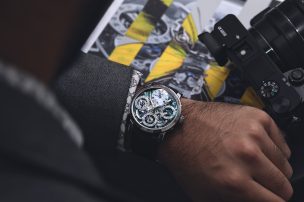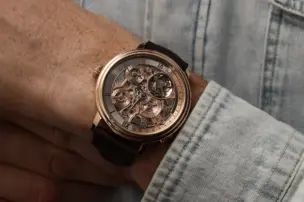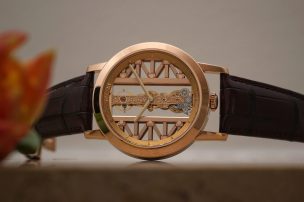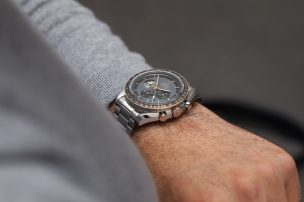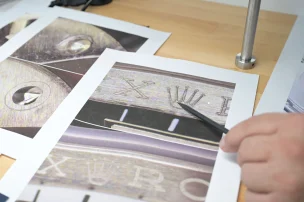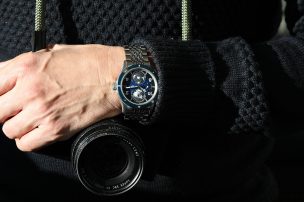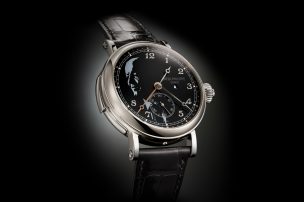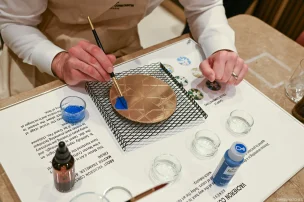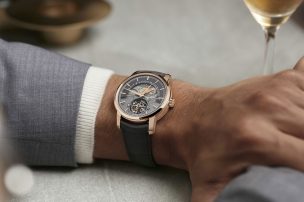
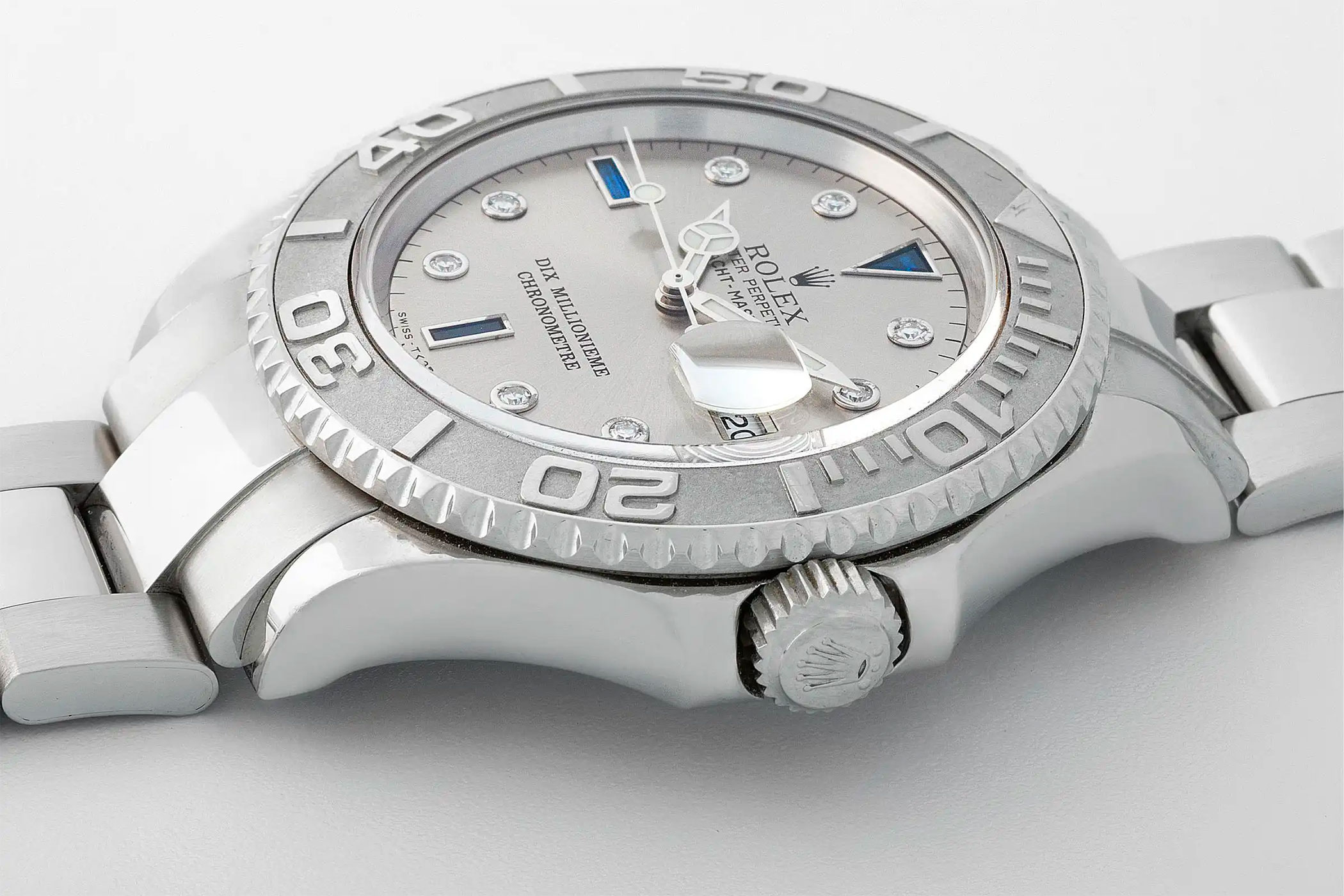
Authentic, Valuable: The Most Beautiful Watches at the Monaco Legend Group Auction
Fans of classic wristwatches always get their fill in spring and autumn, because in May and November, the biggest houses hold their auctions in Geneva. Phillips, Christies, Antiquorum and Sotheby’s each hammer out hundreds of watches, meaning it’s guaranteed that there will be something for everyone.
For the past three years or so, however, the auction season has taken place 4 weeks earlier, drawing watch enthusiasts to beautiful Monaco. The Monaco Legend Group auctions take place as early as April and as late as October. We are here to divulge exactly which pieces constitute the most beautiful, rare, and important lots.
In 2019, renowned Milanese dealer Davide Parmegiani became a partner at the Monaco Legend Group (MLG). Parmegiani achieved worldwide fame by focusing one hundred percent on authenticity and quality from the onset. This was evident not least in the fact that he was always prepared to take responsibility for his merchandise beyond the sale. This set him apart from many other dealers and made him an important contact point for collectors from all over the world. Thanks to his long-standing connections, he always succeeds in presenting extremely rare, valuable and important lots. This is also the case in the current catalogue of the auction on 22 and 23 April at the Meridien Beach Plaza in Monaco, the cover of which is adorned with a very special model: a Rolex Yachtmaster. But to understand it, you have to look very closely.
LOT 100
To understand the desirability of the ‘cover girl’, it helps to trace the history of the model. At first glance, the watch looks like an oft-seen Yachtmaster in steel. Only the dial stands out on closer inspection, because of its precious stones.
The Yachtmaster was introduced in 1992, when Patrick Heiniger became only the third director of Rolex. As is often the case with Rolex, it was initially only available in a gold case, and did not sell that wel. This changed dramatically when the steel version with platinum (‘Rolesium’) bezel and dial was released seven years later. At this point, the Yachtmaster suddenly became suitable for everyday use and thus, everyone wanted it. During the whole seven years before the steel Yachtmaster, however, Patrick Heiniger already owned an example in this sought-after look.
Only, the case and bracelet of his personal watch were also made of platinum. The lot 100 is the only Yachtmaster so far to have appeared that is made entirely of the ‘noblest of metals’. It is also the ten millionth watch for which Rolex has been issued a chronometer certification, which can be read on the dial and movement. Its convincing aesthetics and its uniqueness, combined with documented, prominent previous ownership, make the watch a valuable collector’s item.
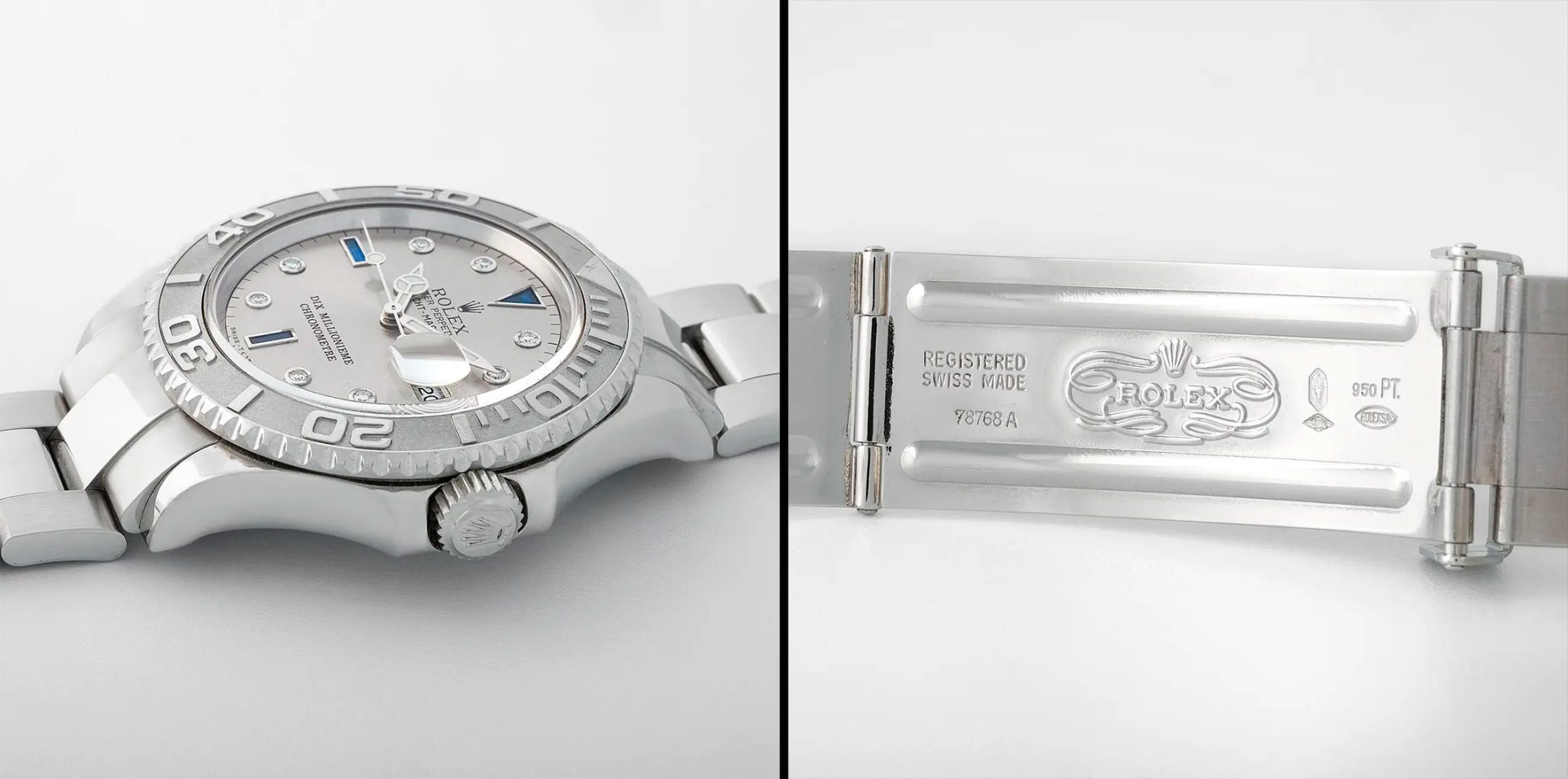
Lot 100: Yachtmaster in platinum from Patrick Heiniger, est. €1 mio. – 2 mio.
LOT 49
Over the years, individualised dials have become rarer at Rolex. Another individualised young timepiece is Lot 49, a Sea-Dweller 16600 ‘Polipetto’, produced in 2008 for the divers of the Italian State Police for the unit’s 50th anniversary, with about 80 pieces made. It is offered in ‘New Old Stock (NOS)’ condition with all fixtures still present. The ‘Polipetto’ has greatly increased in value in recent years.
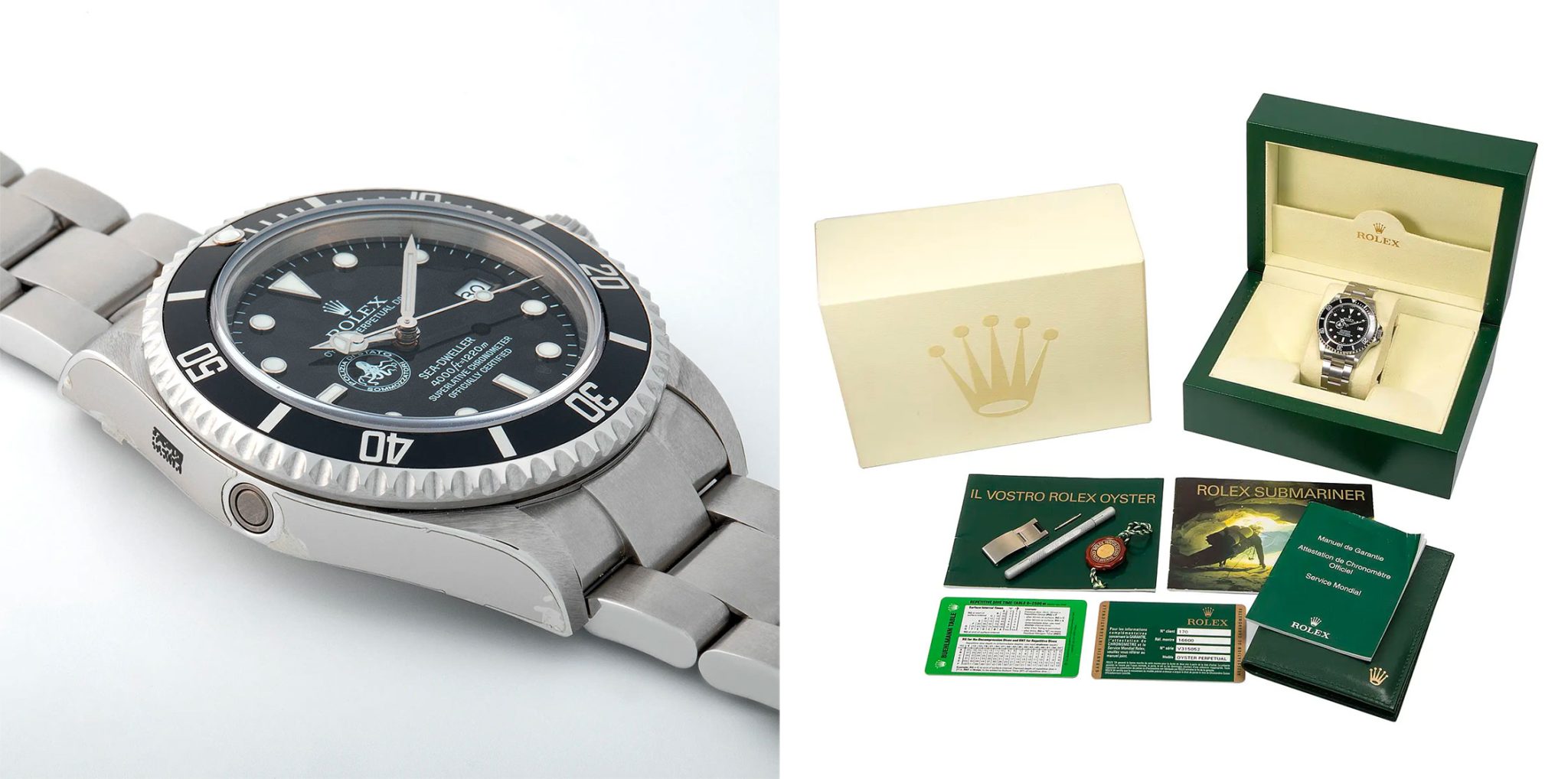
Lot 49: ‘Polipetto’, one of around 80 examples (with protective film), est. €100,000 – 200,000
LOT 261
Among the most common vintage watches with individualised dials are those made to order for influential clients in the Middle East. The watches mostly date from the 1960s and 70s. One of the most important clients in this category was Sultan Qaboos bin Said, who ruled Oman for over 50 years until his death in 2020.
Lot 261 is one of only 12 known ‘Jumbo’ Nautilus models with the reference 3700 in white gold. It comes from the collection of ‘John Goldberger’, probably one of the most famous collectors of vintage wristwatches ever. The watch with a white ‘Khanjar’ logo from Oman is captivating in its beauty, and is sure to fetch a record price.
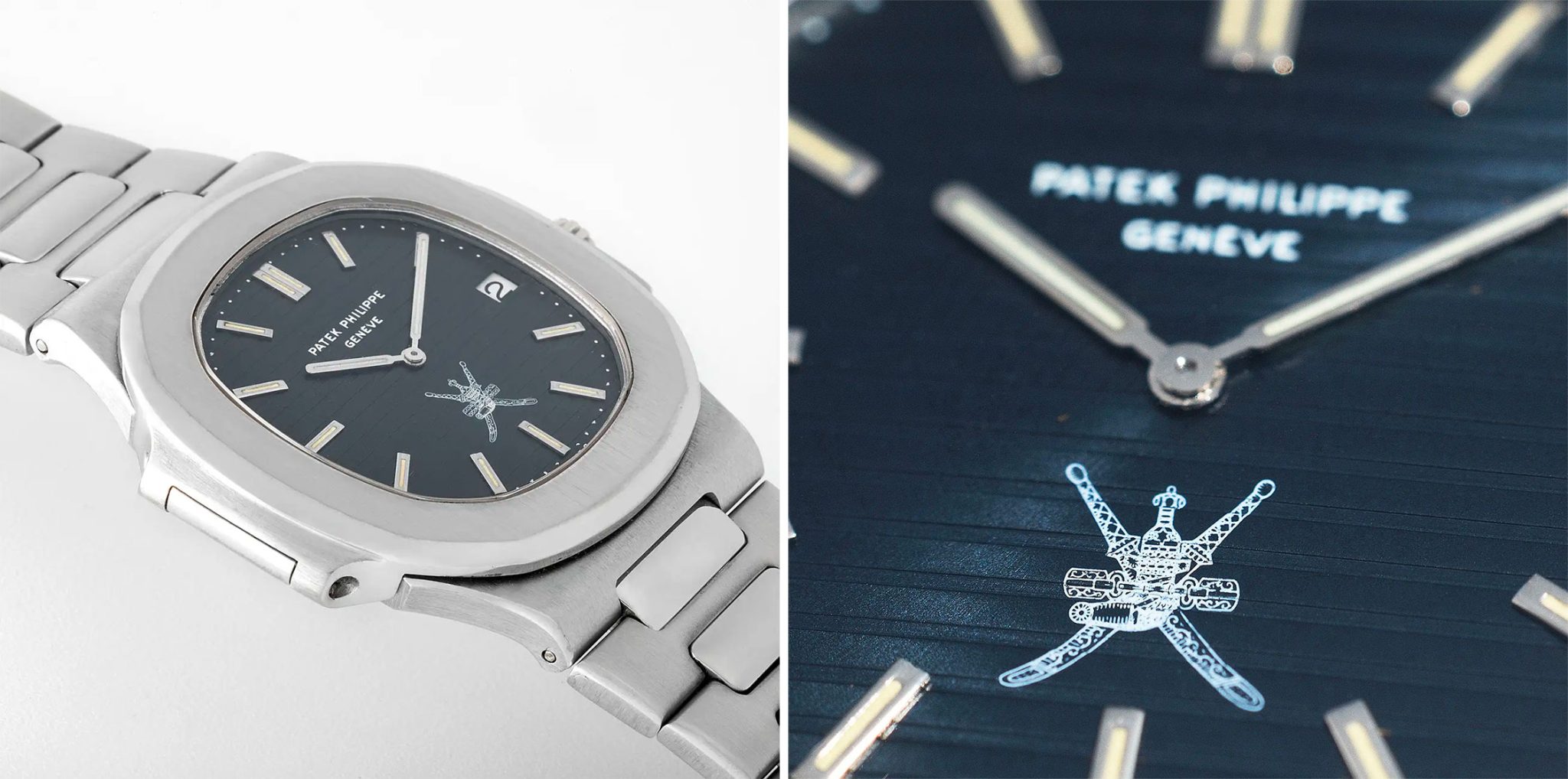
Lot 261: Patek Philippe ‘Jumbo Nautilus Khanjar’, est. €800,000 – 1.6 mio.
LOT 259
Likewise beautiful ‘Jumbo’ Nautilus models can be found in Lots 183 and 259, which, with their steel cases and blue dials, are absolute head-turners to this day, although both were produced 45 years ago. Lot 259 comes with complete accessories.
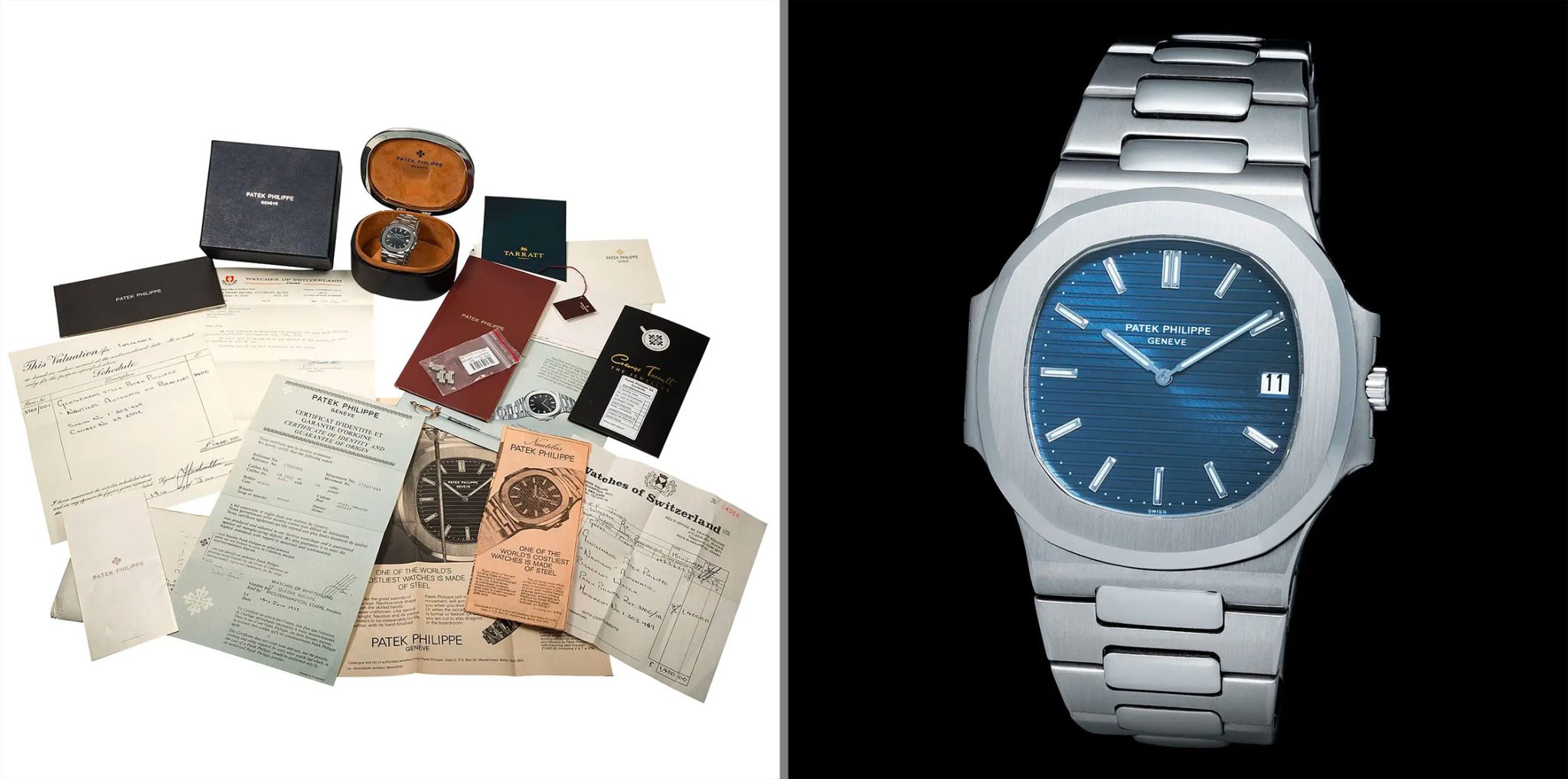
Lot 259, Patek Philippe ‘Jumbo’ Nautilus ‘Blue Jeans’, est. €100,000 – 200,000
LOT 14
Similarly popular to the Nautilus was the Royal Oak from Audemars Piguet in recent years. Like the Nautilus, it was designed by Gerald Genta and was the actual founder of the genre of sporty steel watches in the luxury segment.
Well-preserved examples of the first generation from 1972 fetch top prices at auction. Lot number 14, however, is a modern Royal Oak, which was released last year on the occasion of the Royal Oak’s 50th birthday. This model is also in great demand amongst enthusiasts.
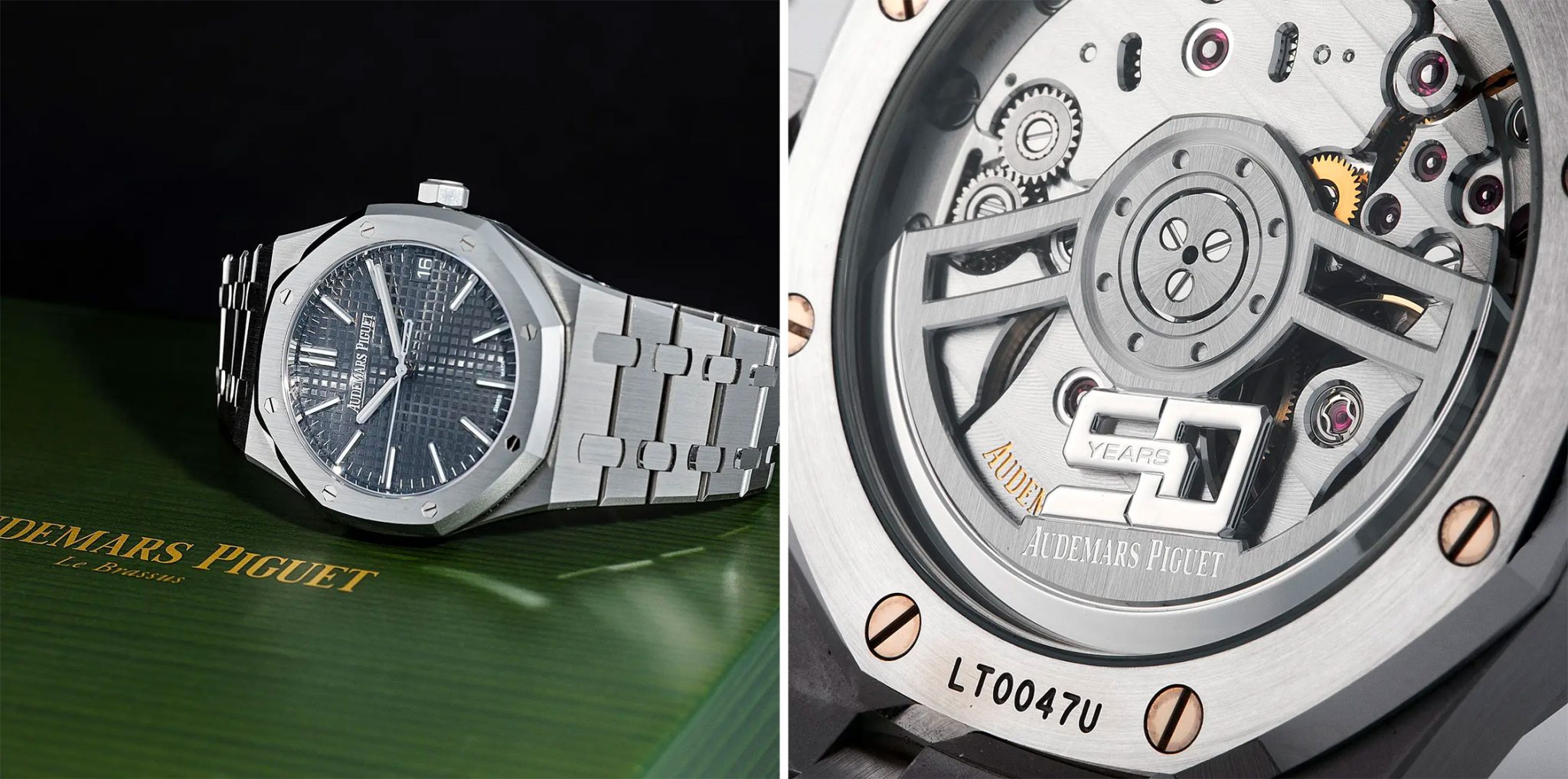
Lot 14: Audemars Piguet Royal Oak 50th Anniversary, est. €30,000 – 60,000
LOT 149
For the established brands of Haute Horlogerie, steel watches have traditionally been more of a side business. At Rolex, however, they are a core business since the introduction of the ‘tool watches’ – Explorer, Submariner, GMT etc. – in the 1950s.
From the very beginning, the Submariner was a huge success for Rolex. Already with Mercedes Gleitze, who swam the English Channel with a Rolex on her wrist in 1927, Rolex positioned itself as an expert for water-resistant watches. Water resistance is at the core of the product promise for diving watches such as the Submariner. Of course, from the very beginning, it also had the automatic winding system, which is also typical of the brand.
But anyone who thinks the automatic is there because the watch is difficult to set or wind under water is mistaken. The automatic rotor keeps the winding mechanism permanently tensed, thus facilitating a constant energy output to the balance. This supports the precision of the watch. In addition, the protection of the movement against foreign bodies is improved because the crown has to be operated less frequently.
The Submariner became legendary through its appearances in the early James Bond films. Dealers like to call all Submariners without crown protection ‘James Bond’. In reality, only a so-called ‘Big Crown’ or ‘Coroncione’ deserves this name, as Sean Connery wore it throughout his role as Commander Bond in his first three films.
It was produced with reference numbers 6200, 6538 and 5510 and was in production for about 6 to 7 years. It is interesting to note that by the time of the first Bond film, the ‘Big Crowns’ had already been replaced by successor models in the catalogue.
Lot 149 is a beautiful reference 6538, presented in rarely seen original dial – hand configuration. The reverse printing of the so-called ‘gilt dials’ is gold-coloured, as are the corresponding hands. The depth rating, on the other hand, is printed in silver. The technical reason for this is that the same blank dials could be used for models with different depth ratings. Only the seconds hand is white, creating a charming contrast – this is also the original.
The red triangle on the bezel is also as it should be for the serial number. The luminous dot in it, on the other hand, seems to be restored, and the outer frame may also be a service part. On original bezels, the nickel plating usually rubs off, revealing the brass colour of the base metal. Service bezels, on the other hand, are made of solid, silver-coloured metal.
However, these minor details are far eclipsed by the beauty of the brown patinated dial. One notable detail: the luminous material of the index at 6 o’clock is always slightly brighter than the rest of the luminous elements in correct specimens, as is the case here.
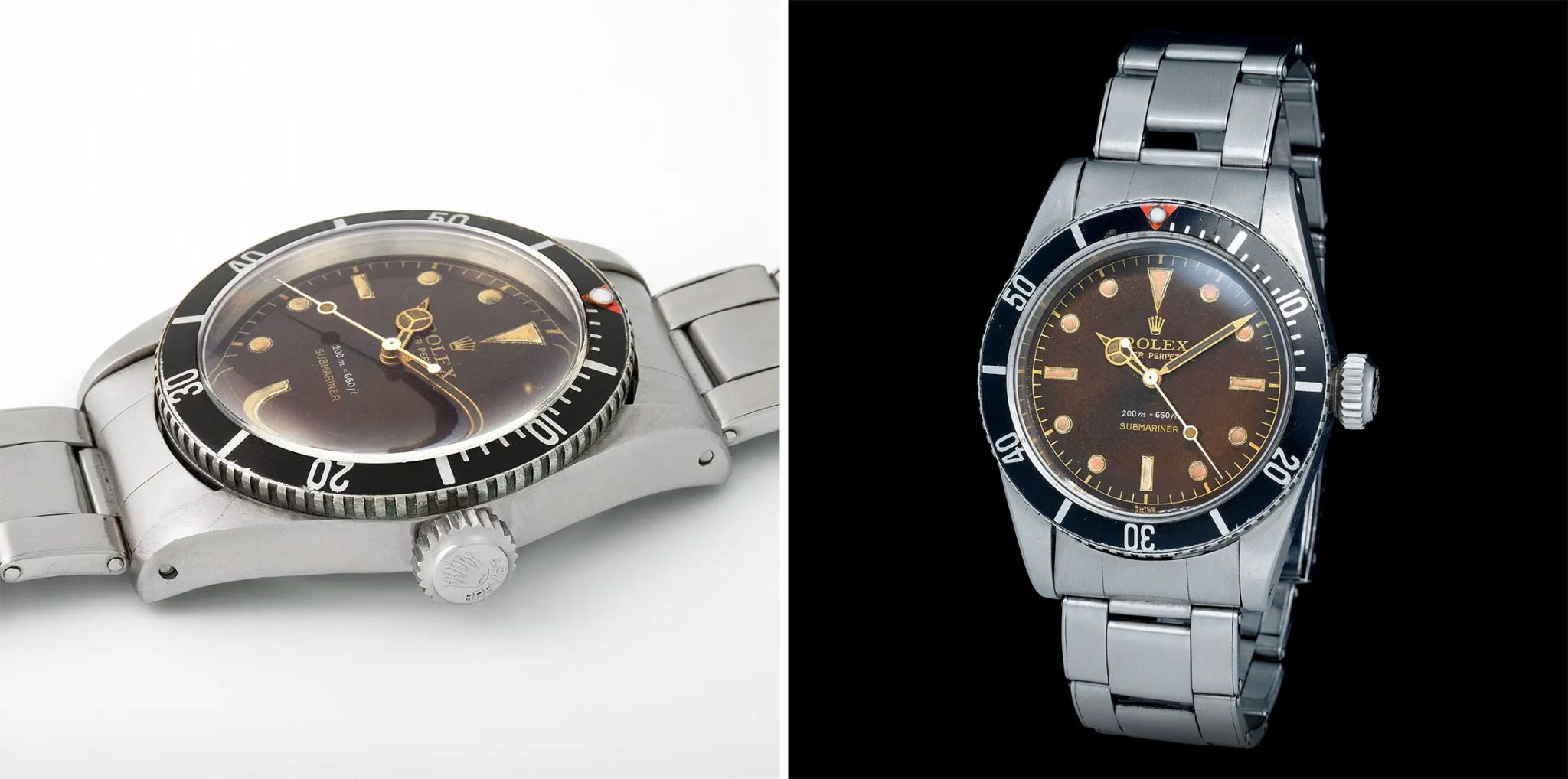
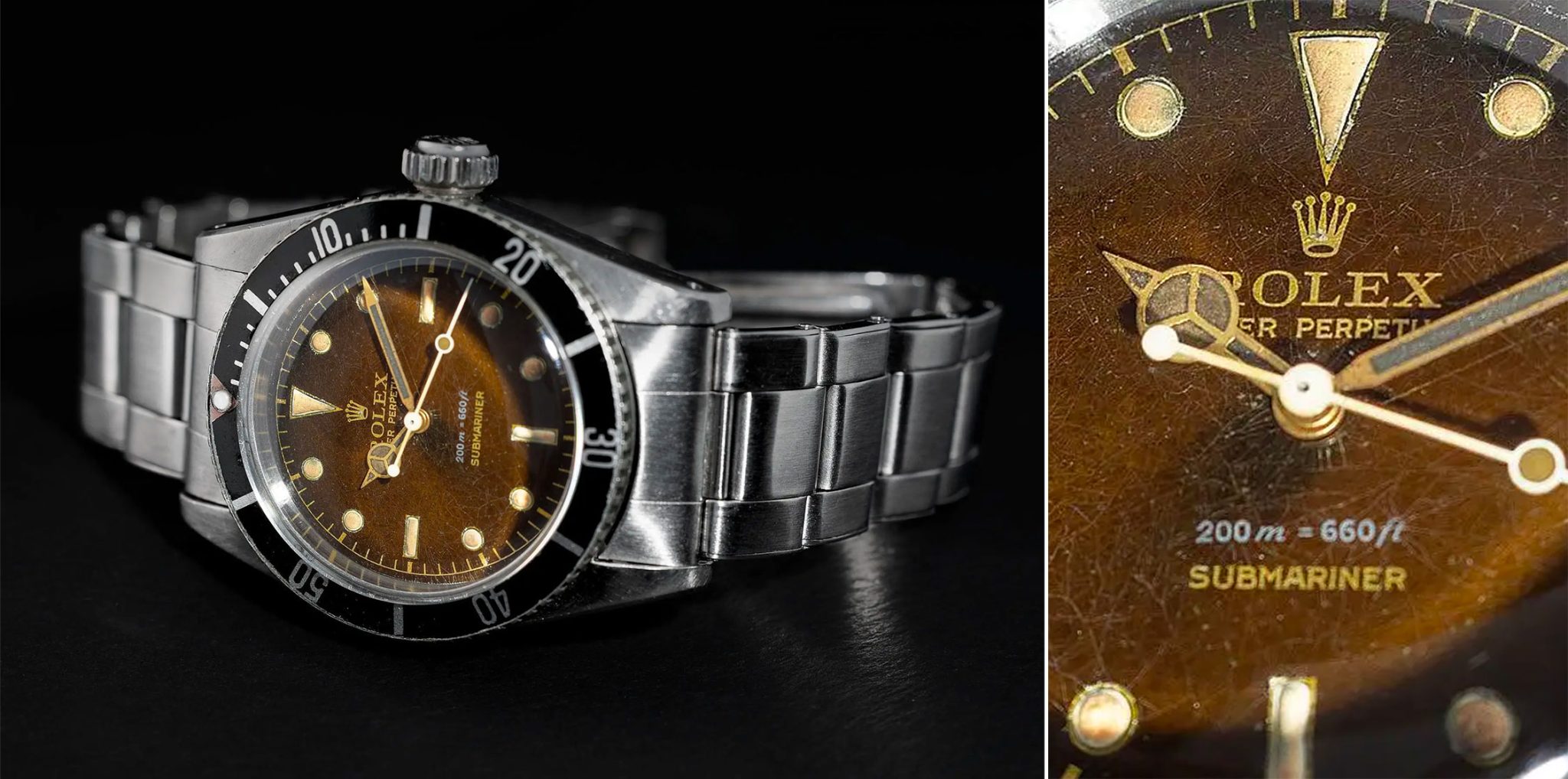
Lot 149, Rolex ‘Big Crown’ Submariner ‘Tropical Dial’, est. €80,000 – 160,000
LOT 243
The crown protector was first used in 1959 with the reference 5512 model. Lot 243 is a reference 5512 with a second-generation crown protector called the ‘Eagle’s Beak’. These models were still fitted with ‘gilt’ dials. The 5512 was also the first Submariner to come with a chronometer certificate as a standard issue.
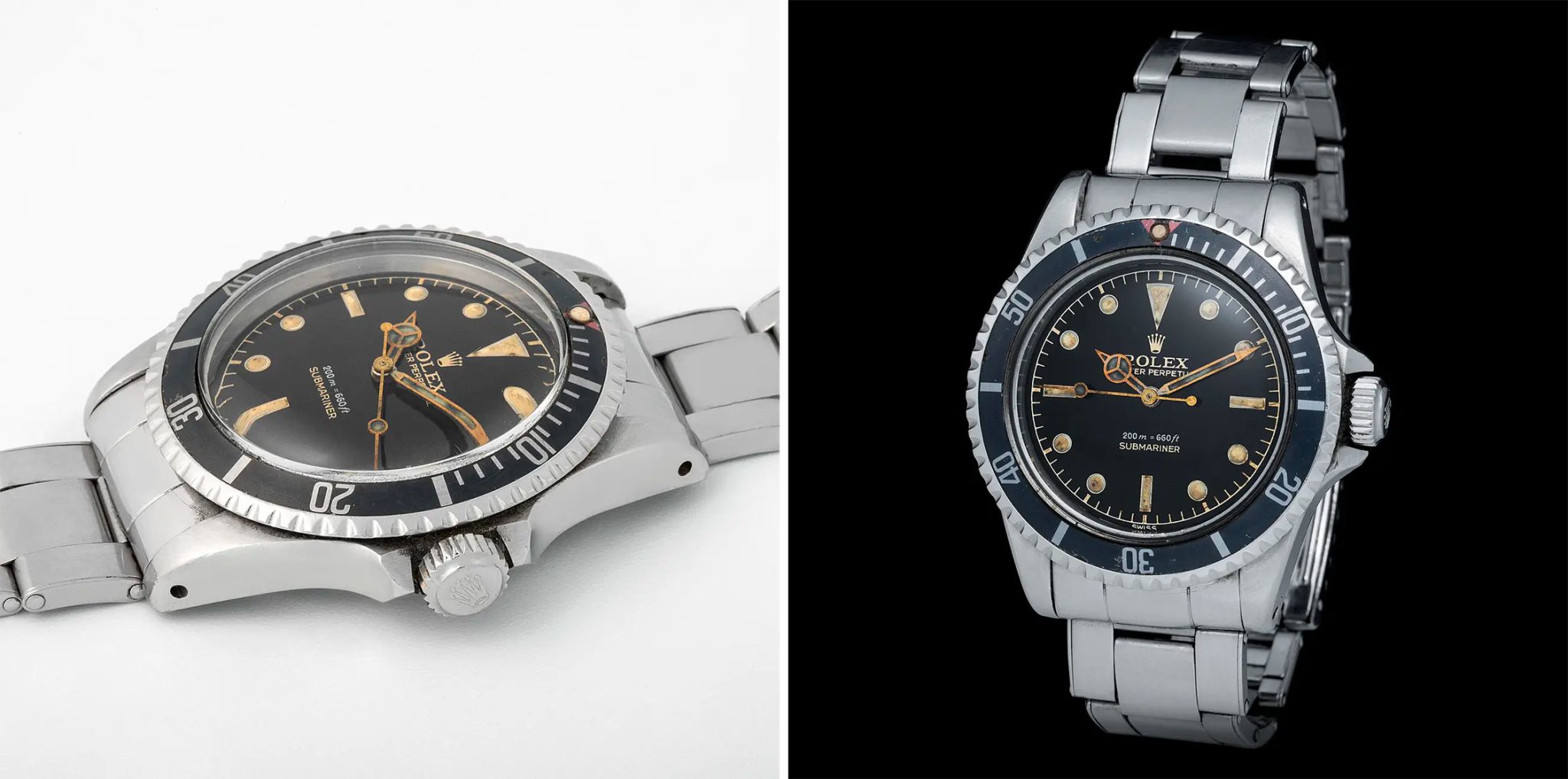
Lot 243, Rolex Submariner Ref. 5512, ‘Eagle’s Beak’, est. €50,000 – 100,000
LOS 104
The most common vintage Sub without date is the model 5513. Lot 104 offers the chance to acquire a late example in patinated new condition (‘NOS’) with accessories. For the right price, it can certainly be a worthwhile investment.
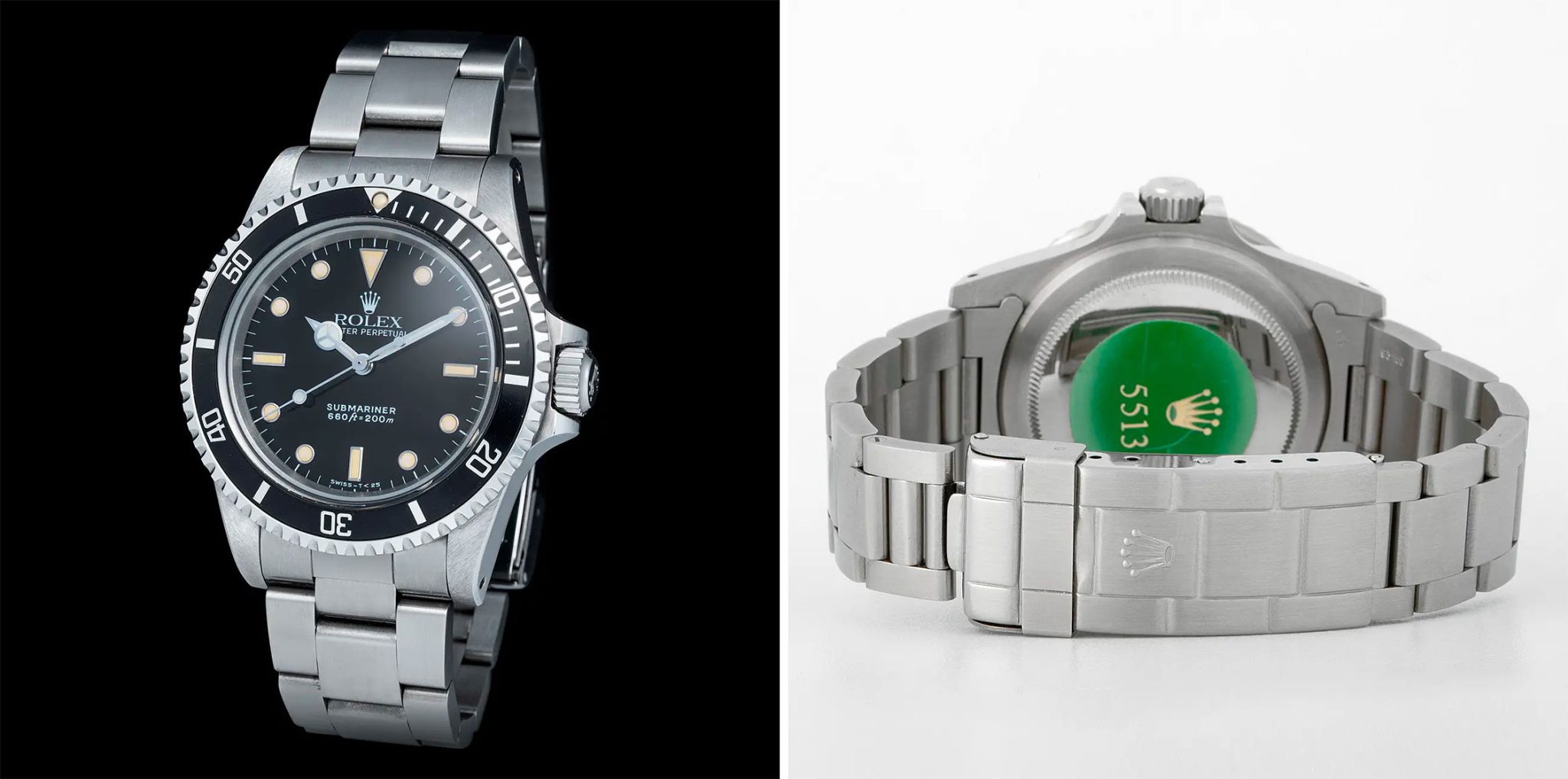
Lot 104: Rolex Submariner Ref. 5513, patinated new condition ‘NOS’, est. €15,000 – 30,000
LOT 10
No auction can be without a Daytona – especially not in an anniversary year. The Daytona is turning sixty! Early examples with manual winding create a collectors’ nirvana like no other. The auction of the Monaco Legend Group is not going to disappoint fans of the Daytona.
It all began with the reference 6239, which André Heiniger, Patrick Heiniger’s father, introduced in 1963 when he took over from Hans Wilsdorf, the Rolex founder who passed away in 1960. The watch came with an engraved bezel and two-tone dial. In 1965, the reference 6240 appeared, and a year later, the 6241. Both models had a bezel with a printed plastic inlay. They differ in terms of pushers, which are already screwed on the 6240 model.
In steel, there are considerably more watches of the reference 6239 than of the 6241 (lots 105 and 170). On the other hand, it seems to be the other way round for gold watches with Paul Newman dials.
Lot 10 is a very nice gold 6239 ‘Paul Newman’ model. The dial is correct for the watch, as can be seen by the gold-coloured graphics on the registers. On later models, the graphics on the registers are white. In addition, the watch is made of 18-carat gold. Golden Daytonas from this period are more common in 14-carat gold, and were intended for the American market. In the US, demand for gold sports watches was always greater than in Europe – and so was production, with import regulations to the USA making the lower gold content more favourable. Yet lot 10 is made of 18 carat-gold, making it is extremely rare and very valuable.
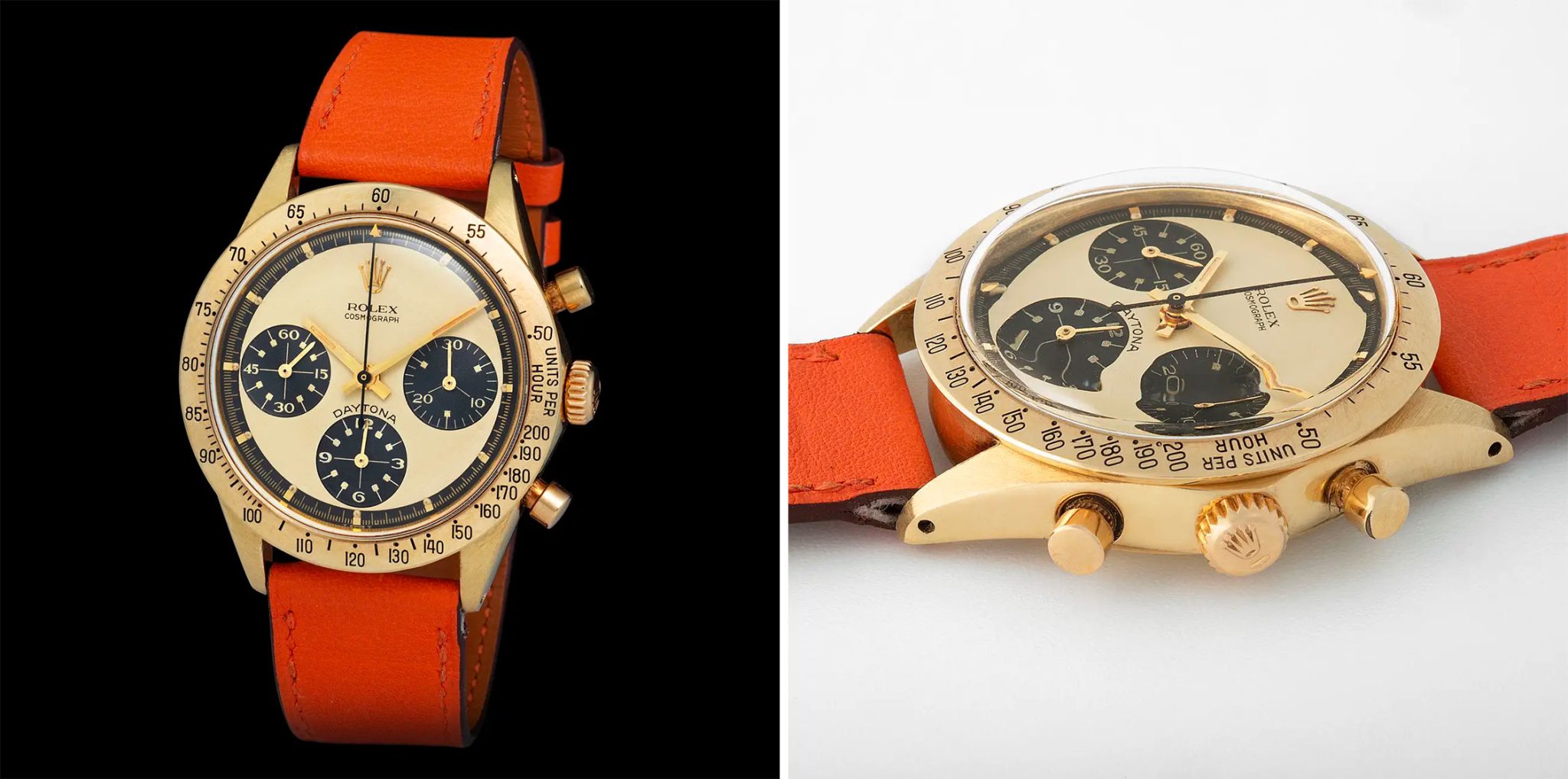
Lot 10: Daytona ref. 6239 with ‘Paul Newman’ dial in 18-carat gold, est. €500,000 – 1 mio.
LOT 249
Lot 249 is the second ‘Paul Newman’ of the auction, now in steel with a black dial. While it is a relatively common reference 6239, the watch’s distinctive feature is the plate-like milled registers ( ‘Musketeer’), which slope at 90 degrees on standard models and are remarkably deeply milled. The serial number of over two million also fits to this dial.

Lot 249: Rolex Daytona Ref. 6239 ‘Musketeer’, est. €180,000 – 360,000
LOT 33
The reference 6240 with screw-down pushers has so far only appeared in steel. The larger pushers and the enlarged crown were apparently not well-received by the public at first. This could explain why the 6241 model with traditional pump pushers was added just one year after its introduction.
There are three generations of screw-down pushers. The first can be easily recognised by the fine fluting (‘Millerighe‘) of the grip notches on the pushers. These were still made of nickel-plated brass. Afterwards, the notches became more pronounced and the metal harder. The second generation differs visually from the third generation in that no line is visible encircling the end of the pusher.
For model 6240, only the first generation, as in lot 33, is correct. The really special thing about this watch is the experimental dial. Besides the obligatory ‘T Swiss T’ at 6 o’clock, ‘Rolex’ is the only lettering (known as ‘Solo’) on the dial. Such dials have also appeared on so-called ‘pre-Daytonas’ with the reference 6238. The ‘Solos’ discovered so far all seem to have serial numbers around 1.2 million, as is the case here. It is unclear whether these dials were intended to standardise the model range. In any case, they are more credible for Daytonas because the contrasting register colours are characteristic here.
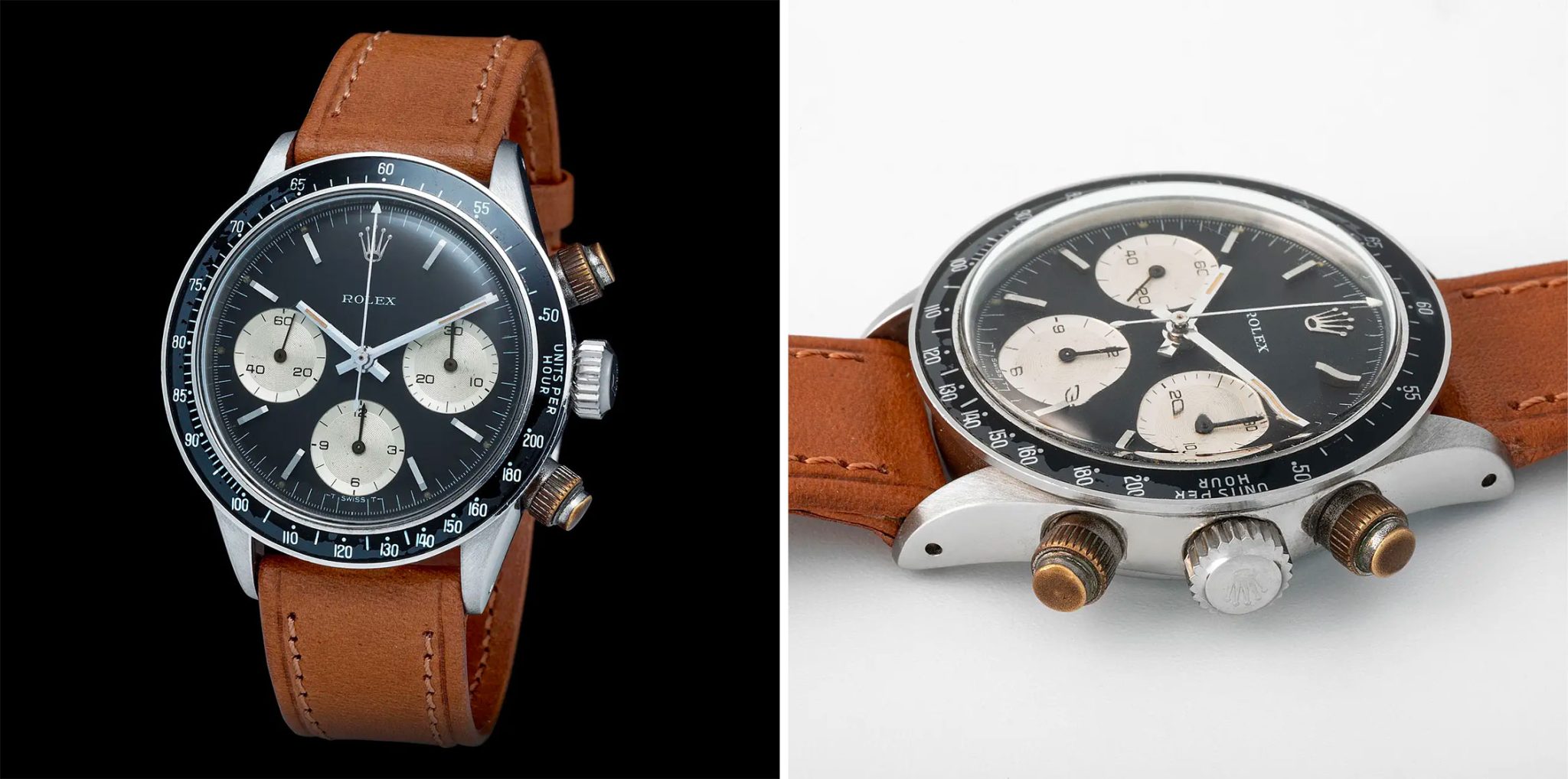
Lot 33: Rolex Daytona, Ref. 6240, ‘Solo Rolex’, est. €100,000 – 200,000
LOT 55 and LOT 160
Two further valuable Daytonas are lots 55 and 160, which have individualised dials. The former, lot 55, is a reference 6265 in steel with a ‘UAE Quraysh Hawk Dial’, also known as ‘Desert Eagle’ amongst less erudite fans. The Rolex lettering had to give way to the hawk. It was certainly not easy to persuade the officials in Geneva to do this – but in the end, they made quite the effort. The close-up shows the high art of tampography. The colour segments of the logo are cleanly separated with an incredibly fine lines, and the inscribed characters are crystal clear. The gold of the plumage is particularly difficult to work with, as the pigment size is much larger with metallic colours than with white, black or red. A true feast for the eyes!
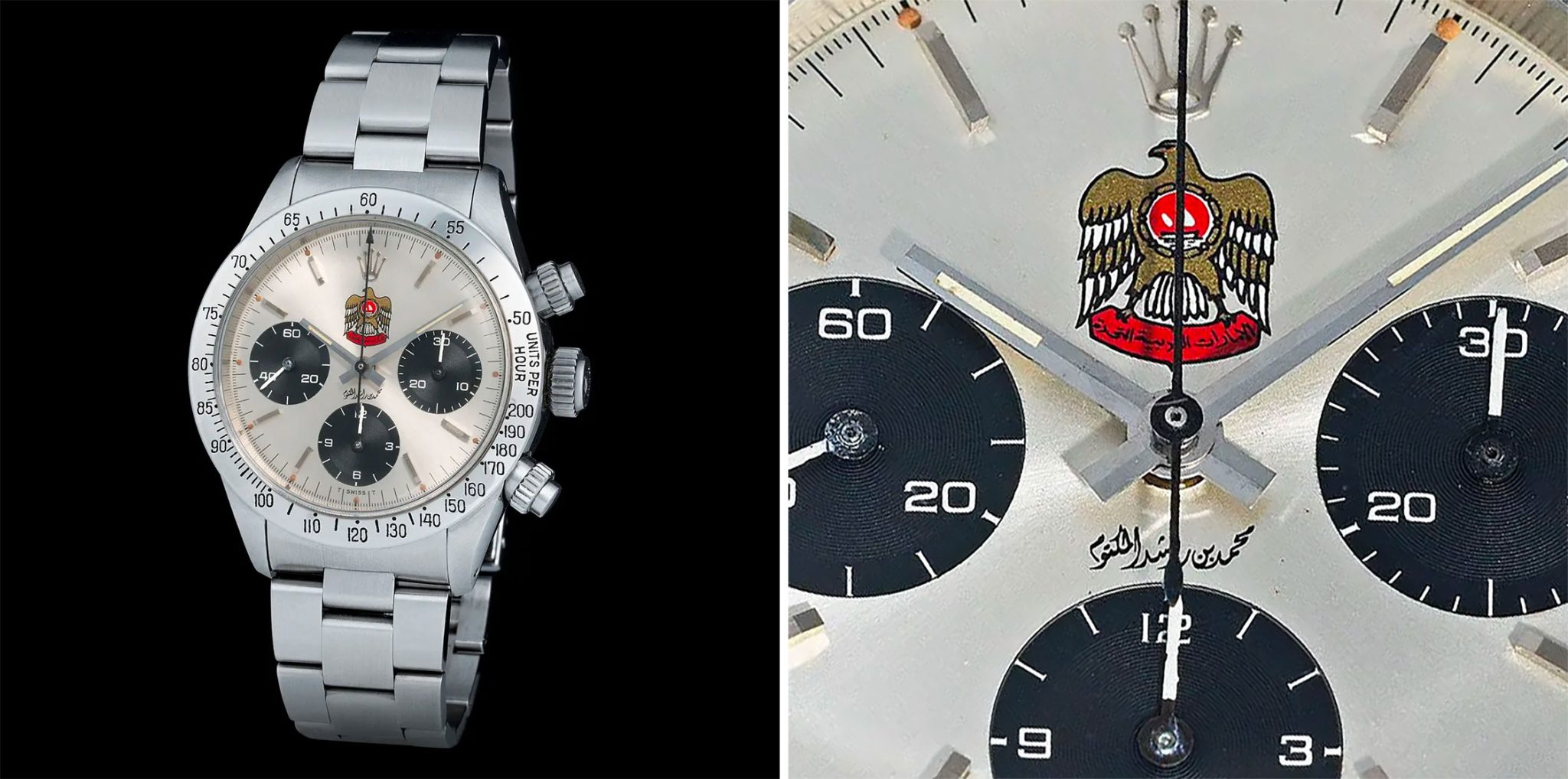
Lot 55: Rolex Daytona Ref. 6265, ‘Desert Eagle’, est. €250,000 – 500,000
A high-up servant of the Sultan was honoured with lot 160. A Daytona in gold with an individualised dial is a special find. The watch has a very special aesthetic. The combination of gold with a black dial is not everyone’s cup of tea at first glance. Even during the production of the dial, an attempt was made to soften the harsh contrast by using champagne-coloured registers. Time has done the rest and muted the black. This creates a surprising harmony, which is only broken up by the ‘Red Khanjar’. The logo stands out clearly in red. The close-up (below) brings out the sublime ‘relief print’ here; an art that is difficult to find in this level of detailed perfection, even in Switzerland today. Compare the refinement of the ‘Khanjar’ logo with that of the gold-coloured Rolex lettering itself.
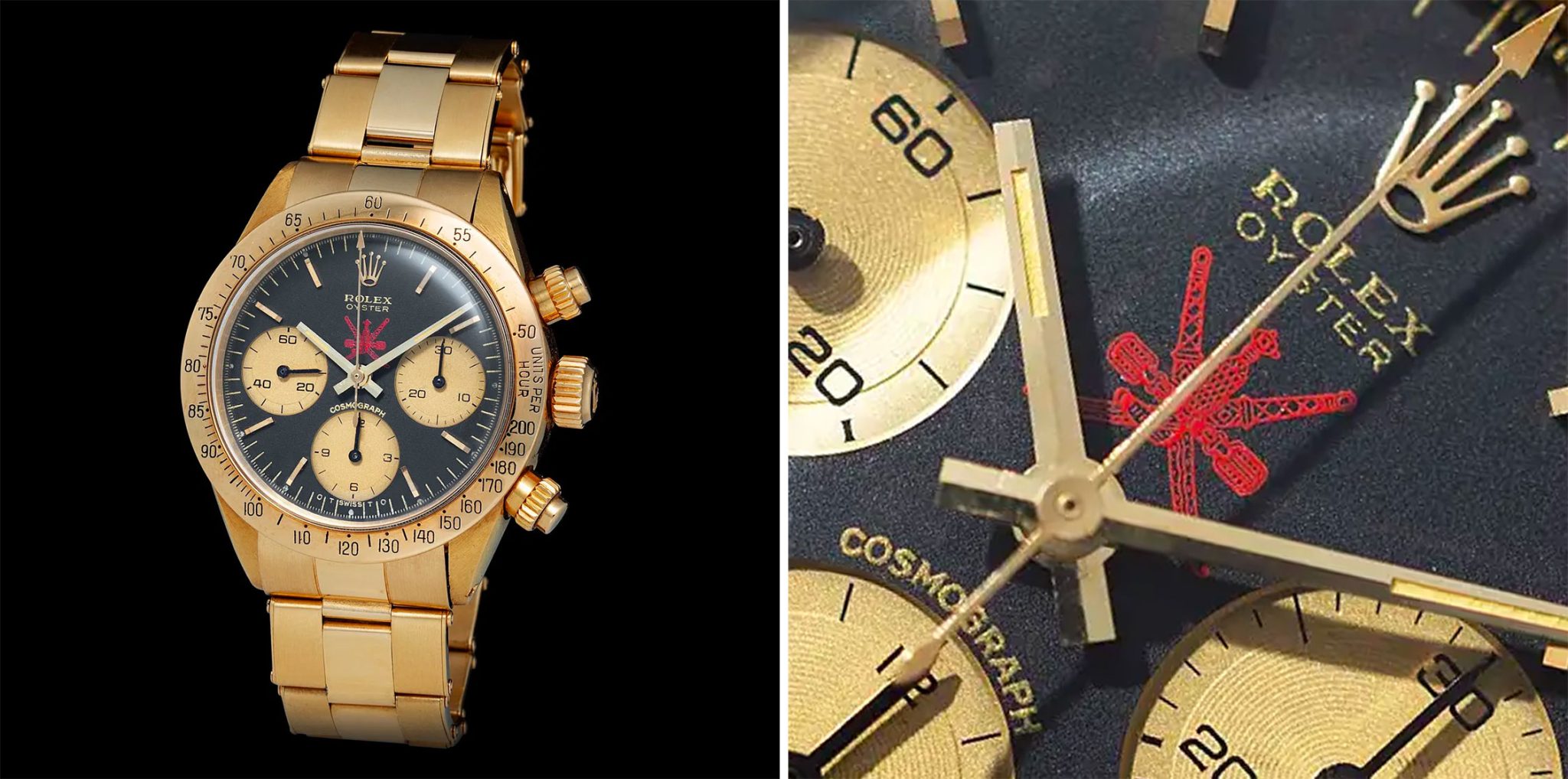
Lot 160: Rolex Daytona Ref. 6265 in gold with ‘Red Kanjar’ logo, est. €500,000 – 1 mio.
LOT 229
When Rolex introduced the Daytona in 1963, Omega had already had the Speedmaster with engraved bezel on the market for several years. At that time, the Speedmaster still featured crown wheel movements based on the Lémania ‘1873’ calibre. Lot 229 is an early example of a ‘Broad Arrow’, featuring a beautiful patina.
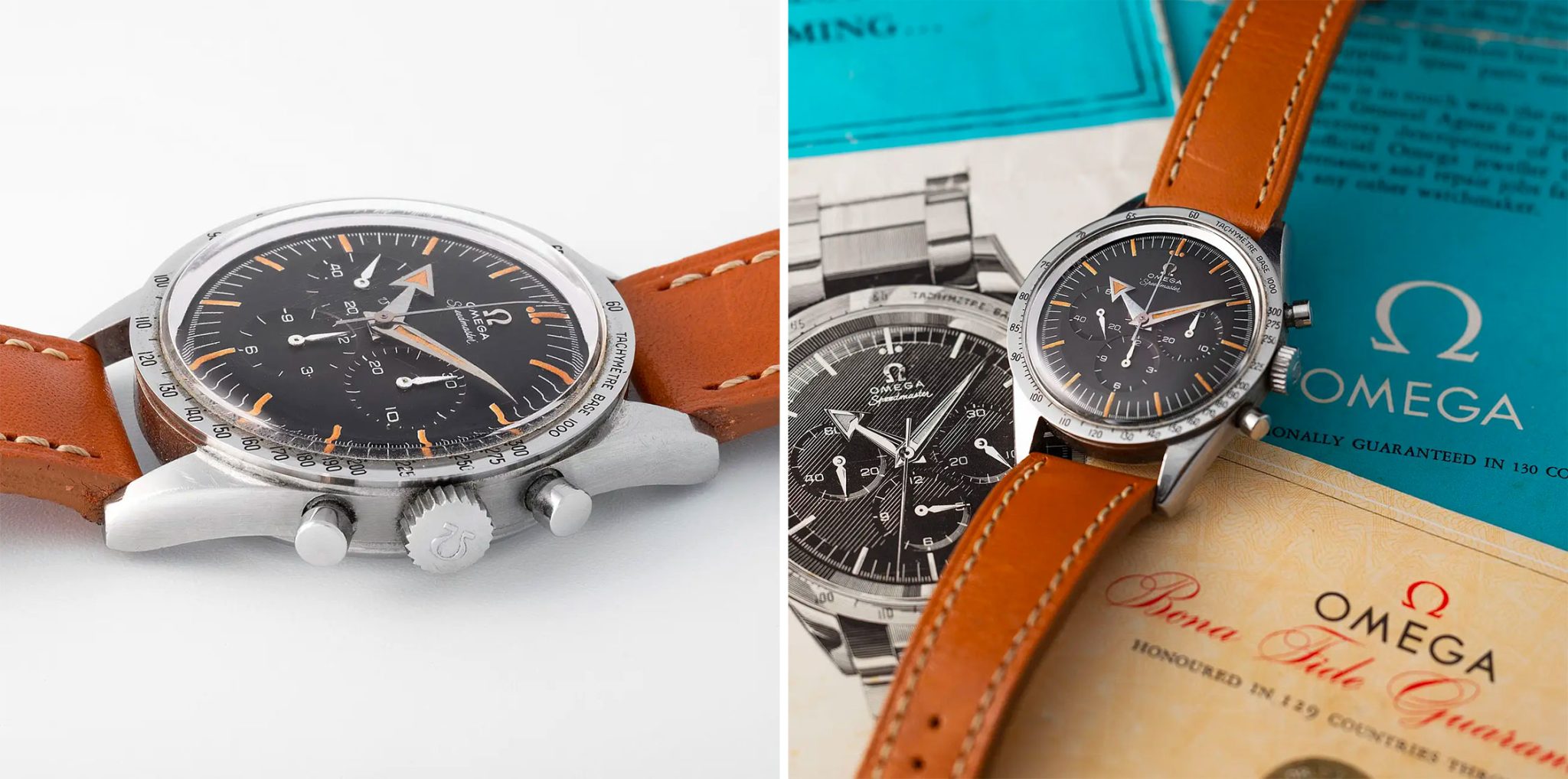
Lot 229: Omega Speedmaster ‘Broad Arrow’, est. €150,000 – 300,000
LOT 63
First-generation automatic Daytonas with modified Zenith ‘El Primero’ movements are also highly sought after. However, something special has to be offered to boost the prices. At the top of the list is the ‘R-Series’, i.e. early examples with so-called ‘floating dials’, where the ‘Cosmograph‘ lettering is lower than on later versions.
Floating dials are particularly valuable when several layers of clear lacquer form the base for the final print (‘porcelain’). This creates an optical depth that makes the graphic appear three-dimensional. For the black version, the ‘Patrizzi dial’, where the rings in the registers turn brown, is in great demand.
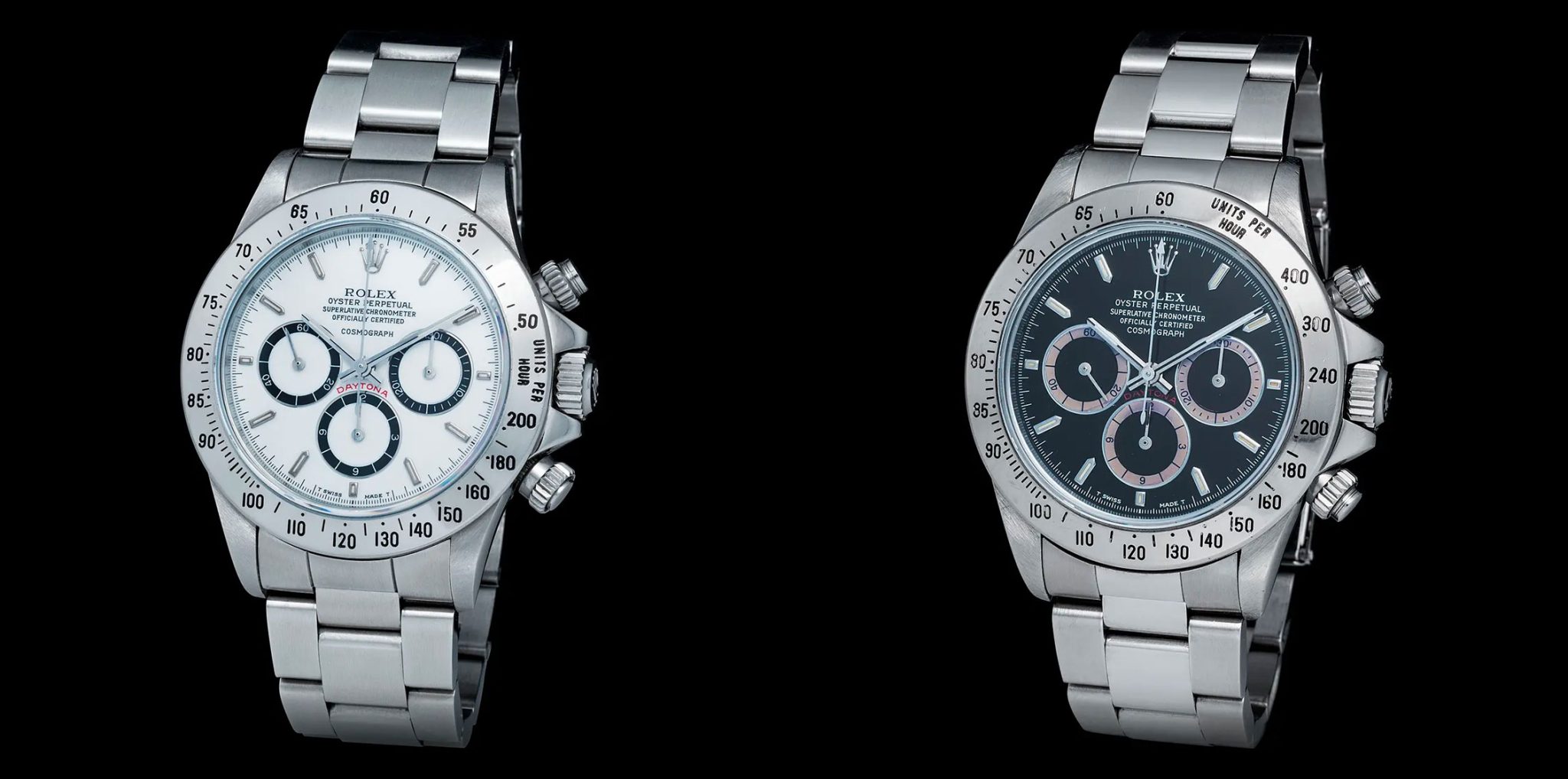
Lot 63, Rolex Daytona Ref. 16520 ‘Porcelain Floating’, est. € 100.000-200.000, Lot 200 with ‘Patrizzi’ Dial, est. €25,000 – 50,000
LOT 188
For Rolex, it has always been a goal to produce water-resistant chronographs in order to fulfil the Oyster concept for this type of watch as well. For Patek Philippe, on the other hand, the focus was typically on elegant jewellery watches with snap-on case-backs, more suitable for the grandstand than for the competition itself.
One exception was the 1463 model with its water-resistant, screw-down case-back by the ‘Taubert Freres’ atelier, which emerged from the company Borgel. Borgel was a pioneer of water- and dust-resistant cases. The engraved pushers are typical for the model, with Italian enthusiasts christening them ‘Tasti Tondi’.
Lot 188 is certainly one of the most beautiful watches in the auction. Its special charm comes from the rose-gold case. The warm metallic tone seems to contrast with the sporty masculine case shape. The perfectly preserved dial of the watch supports this special aura with its beautiful patina.
Dials that are not printed, but rather enamelled, are typical for Pateks of the 1950s and 60s, giving the lettering a slightly raised appearance. Also typical is the grained, ivory-coloured silvered surface (‘opaline’), which is contrasted on this beautiful dial with another silver tone towards the edge (‘two tone’).
The lot is offered with complete documentation and has a provenance that began at the renowned Turin jeweller ‘Astrua’. Less than 50 rose-gold ‘Tasti Tondi’ models have surfaced to date.
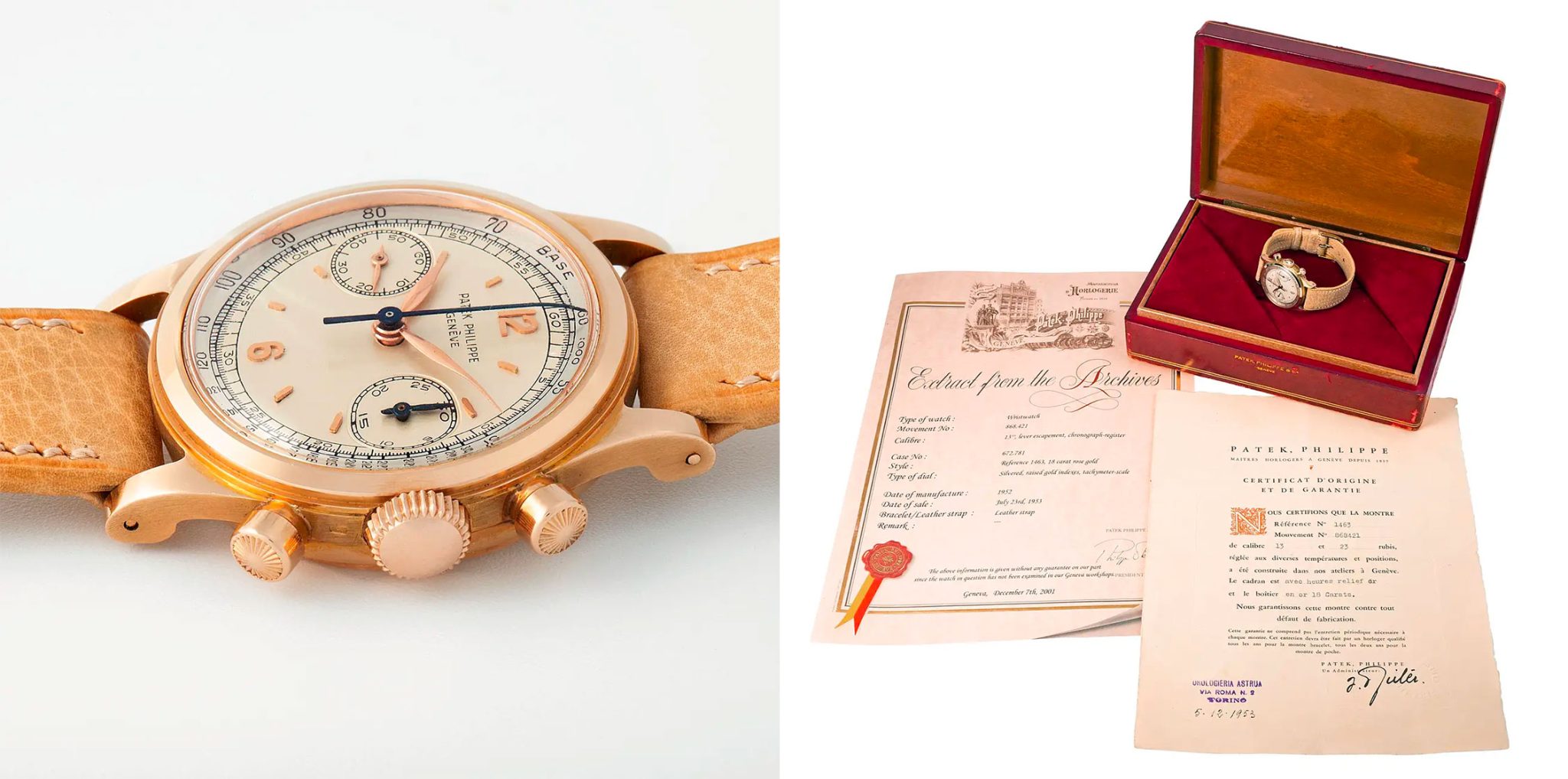
Lot 188: Patek Philippe, ref. 1463 ‘Tasti Tondi’ in rose gold, est. €300,000 – 600,000
LOT 164 and LOT 238
Other ‘Important Watches’ from Patek Philippe are lots 164 and 238. Lot 164 is a World Time watch based on the calibre 12-400, which uses a mechanism patented by Louis Cottier to measure the time in places in different time zones. Sold in 1968, it is a very late example and one can imagine that with this purchase, the proud buyer perhaps wanted to prepare for forthcoming supersonic speed Atlantic crossings in the then-new Concord. In any case, it belonged to an important personality.
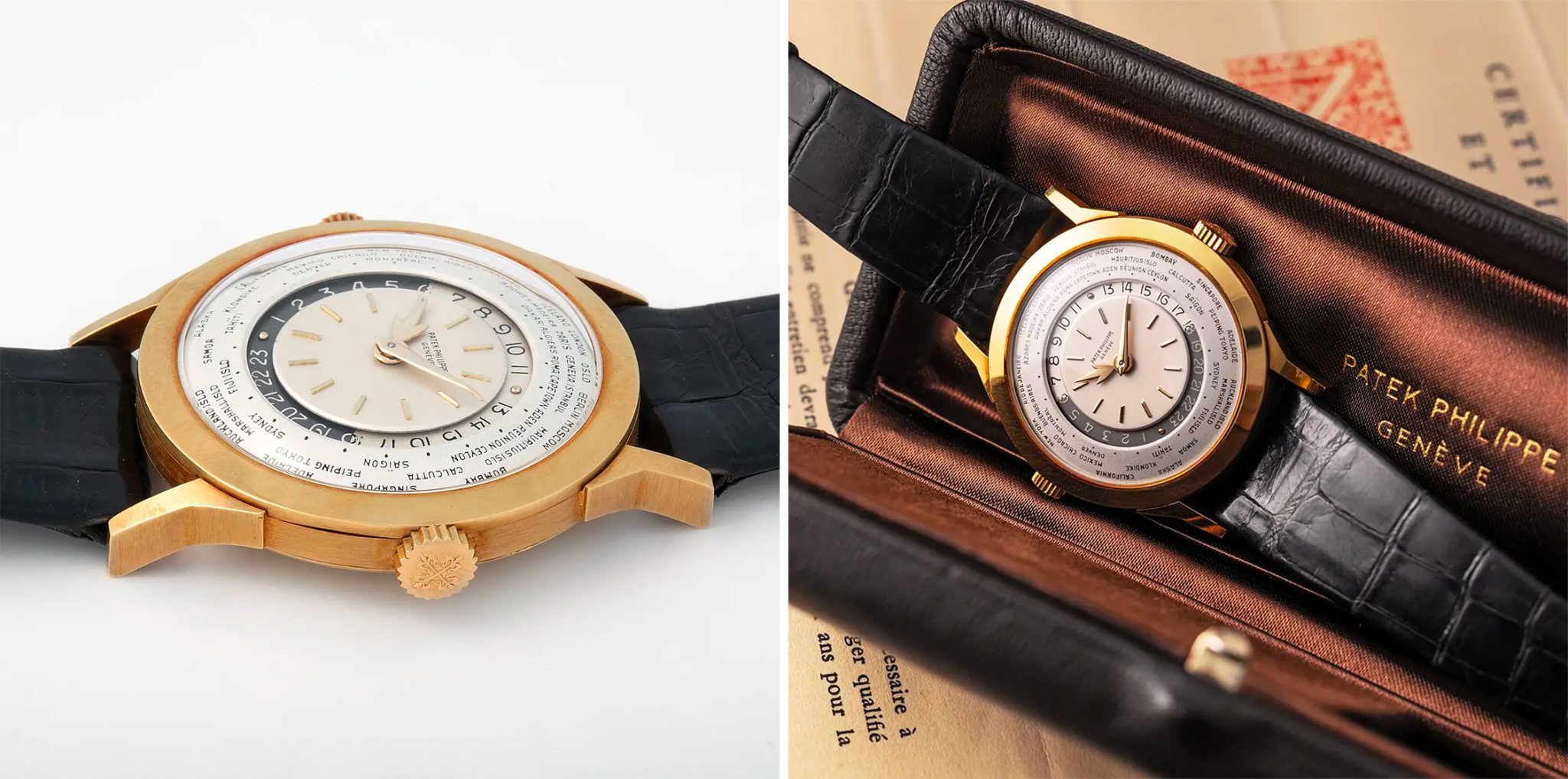
Lot 164: ref. 2523/ 1 HU ‘Heure Universelle’, est. €2 mio. – 4 mio.
Lot 238 is a 1950s dress watch with an enamelled dial using the cloisonné technique. With this technique, the different colour segments are separated with a fine gold wire. This wire is soldered on by hand before the colours are inlaid and fired. The melting point of the gold is higher than that of the enamel.
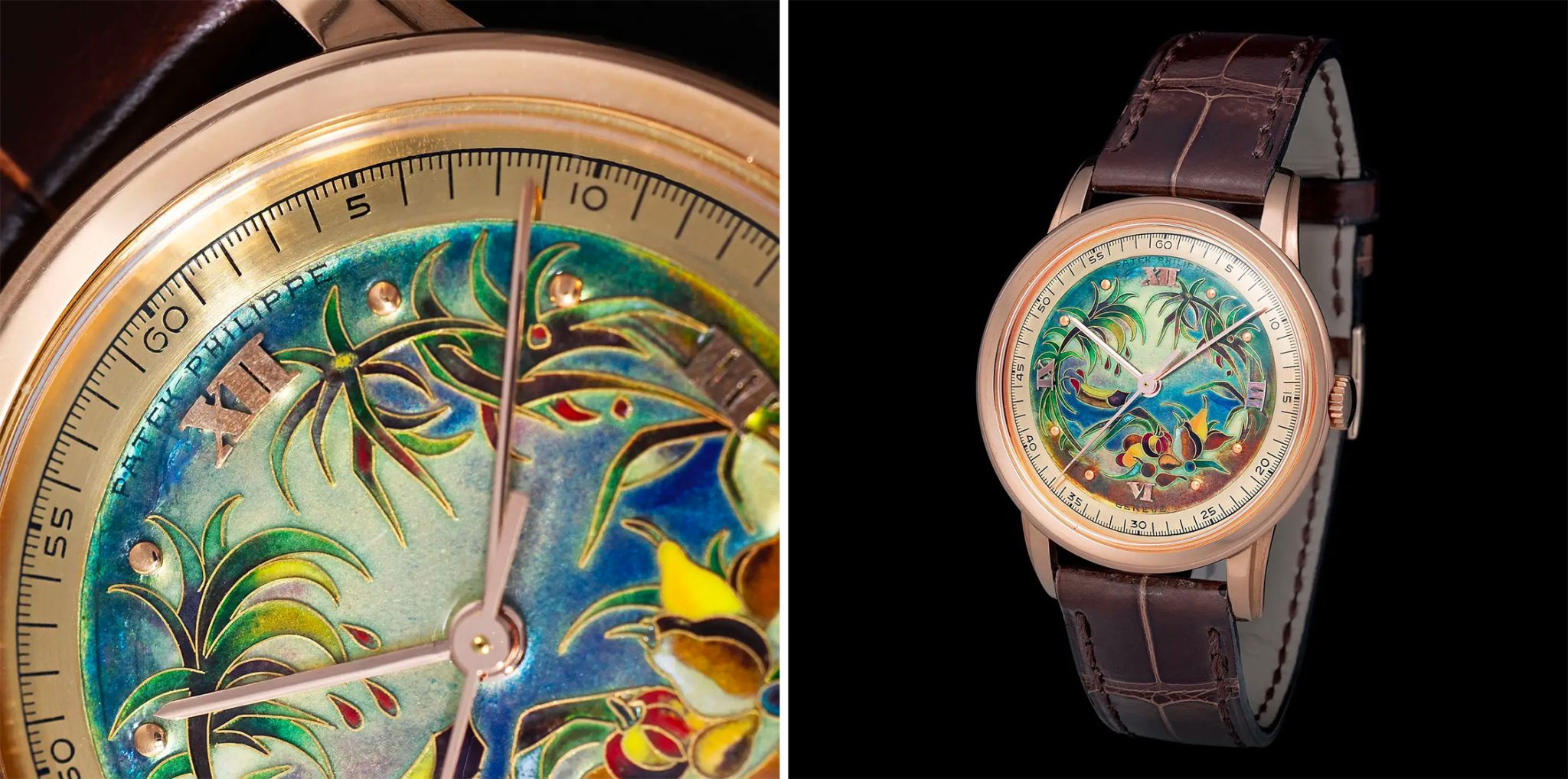
Lot 238, Patek Philippe Ref. 2481 ‘Cloisonné’, est. €450,000 – 900,000
LOT 67 and LOT 129
In the ranking of traditional luxury brands, Audemars Piguet occupies a place just behind Patek. Only a few vintage wristwatches come onto the market. Quality is offered at the highest level, which often leads to high prices at auction.
While Patek Philippe was born as a brand in Geneva that purchased raw movements from the Jura at the beginning of the wristwatch era, Audemars Piguet emerged as a Jura-based raw movement producer that oriented itself in the opposite direction towards Geneva. Today, both brands are emblematic of Swiss watchmaking.
Lots 67 and 129 are sought-after collectors’ pieces of the brand. Lot 67 is an automatic watch in a gold Carrée Galbée case, also known by collectors as a ‘Cioccolatone‘.
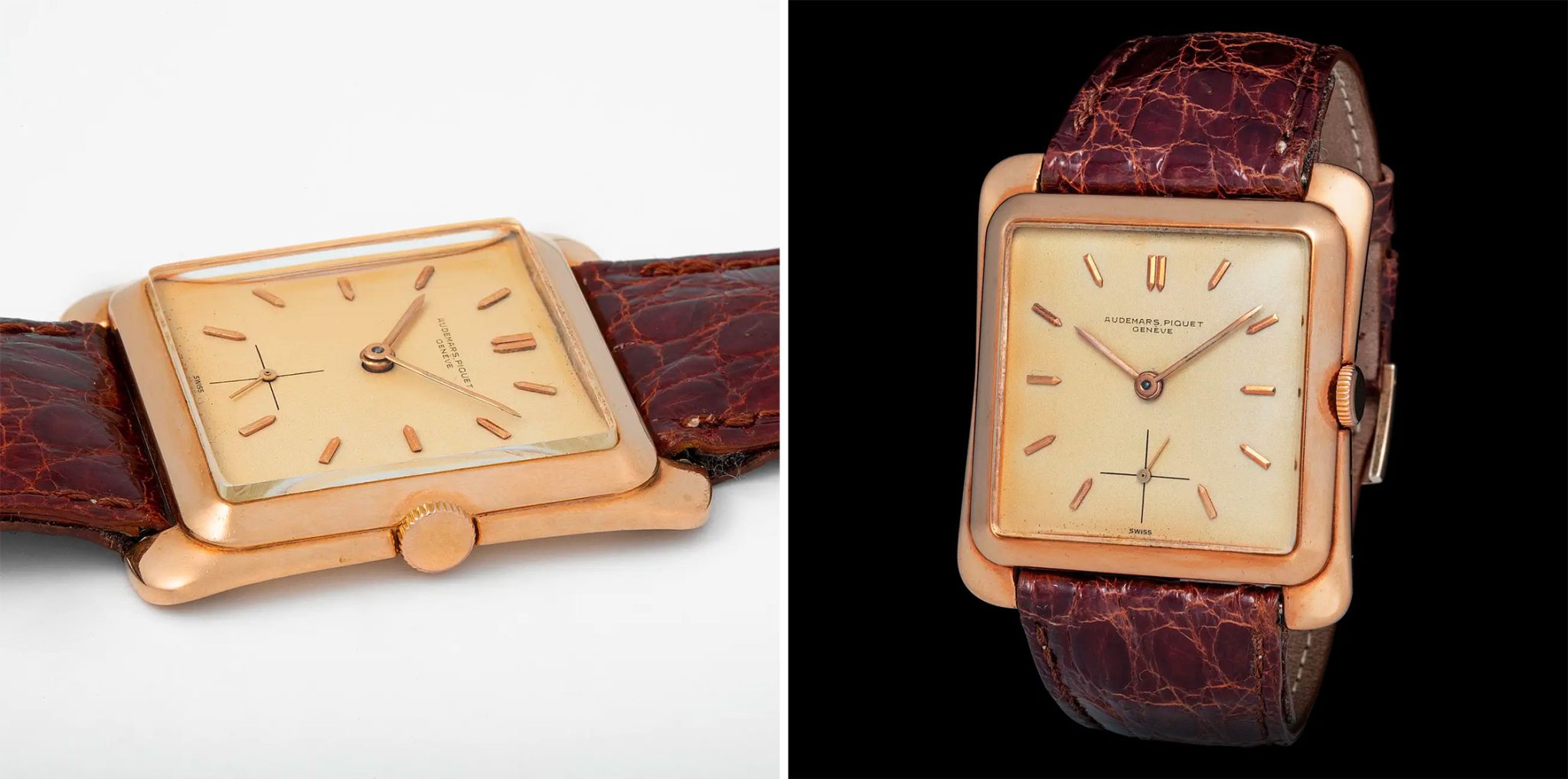
Lot 67: Audemars Piguet ‘Cioccolatone” automatic Audemars Piguet in ‘Carrée Galbée’ case, est. €20,000 – 40,000
Lot 129 is a small annual calendar with moonphase, also in a square case. For this lot, prospective buyers should be sure to check the condition of the dial before bidding.
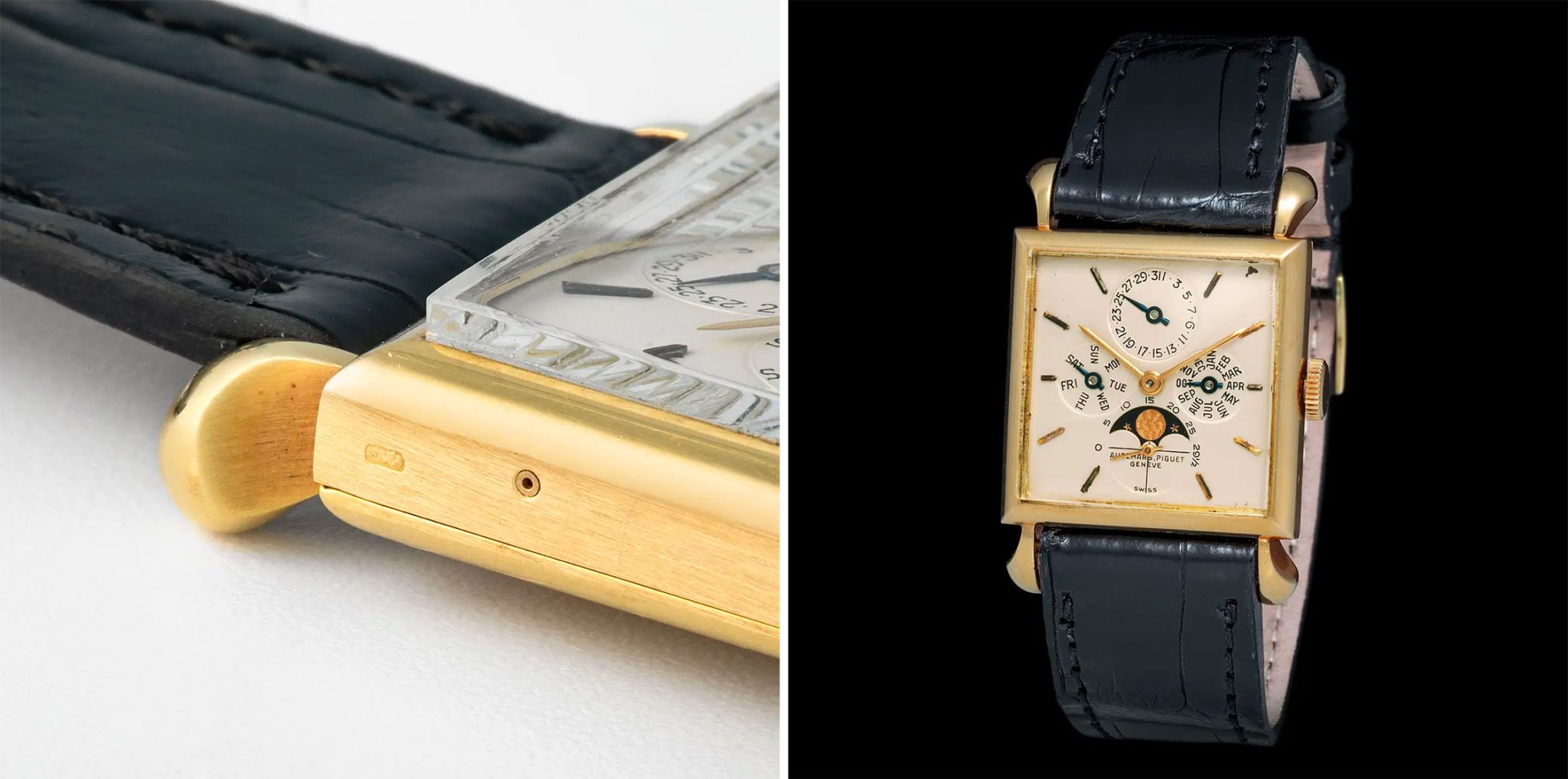
Lot 129: Audemars Piguet Vintage Annual Calendar, est. €150,000 – 300,000
LOT 44
Third in the line-up of traditional luxury brands is Vacheron Constantin, the oldest Genevan ‘maison’ continuously in operation. Vintage watches from Vacheron have more of a difficult time on the market to sell than those from Patek or Audemars. Lot 44, however, is a spectacular piece for connoisseurs: a wristwatch measuring only 36 mm, fitted with a minute repeater. The side view proves the slimness of the case with ‘teardrop lugs’; very impressive for a striking movement and proof of the high craftsmanship of the horology house.
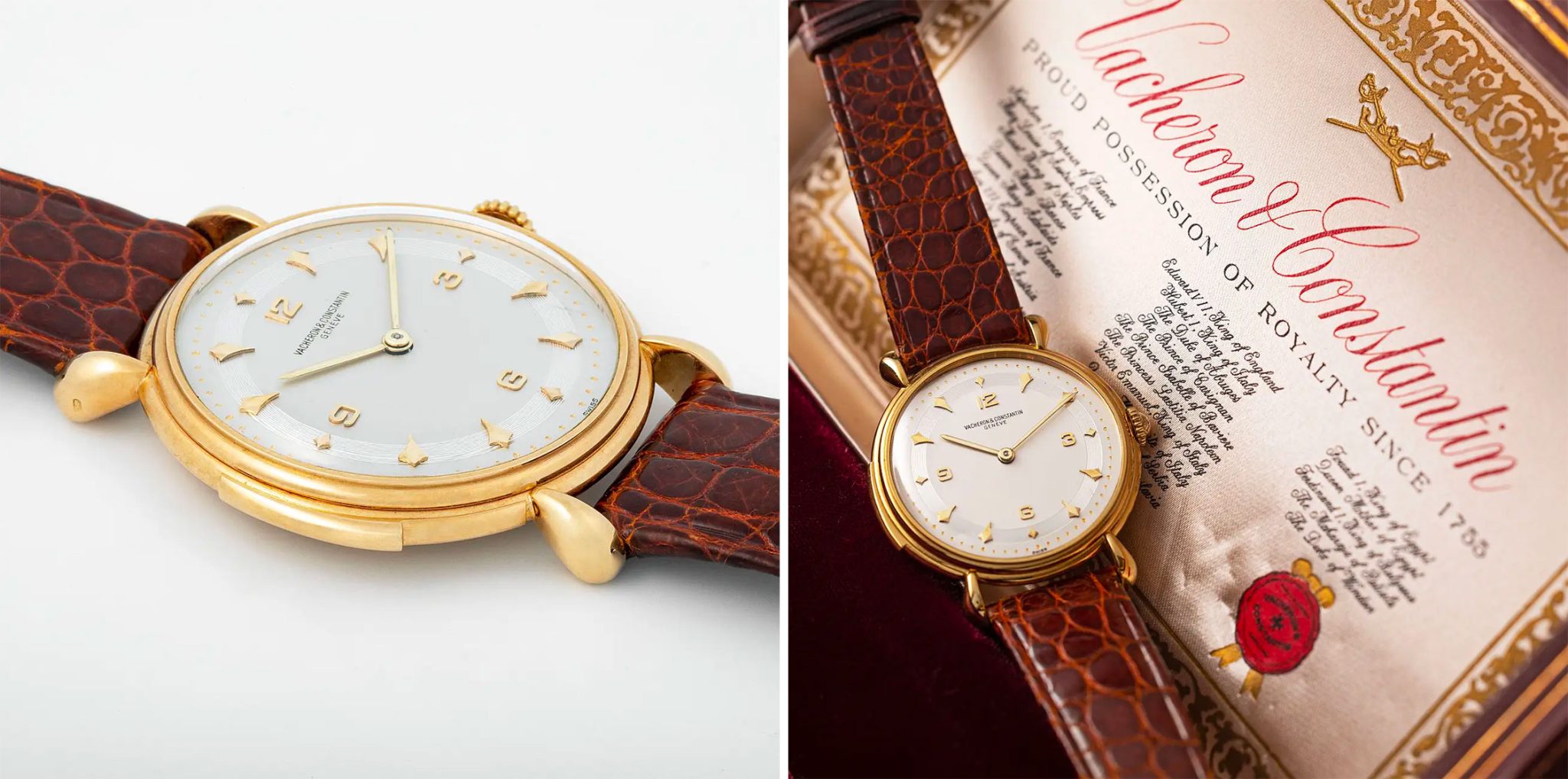
Lot 44: Vacheron Constantin with minute repeater, est. €200,000 – 400,000
LOT 186 and LOT 223
Back in the sphere of affordable vintage watches, in search of investments with stable values, the eye falls on gold GMTs and Submariners.
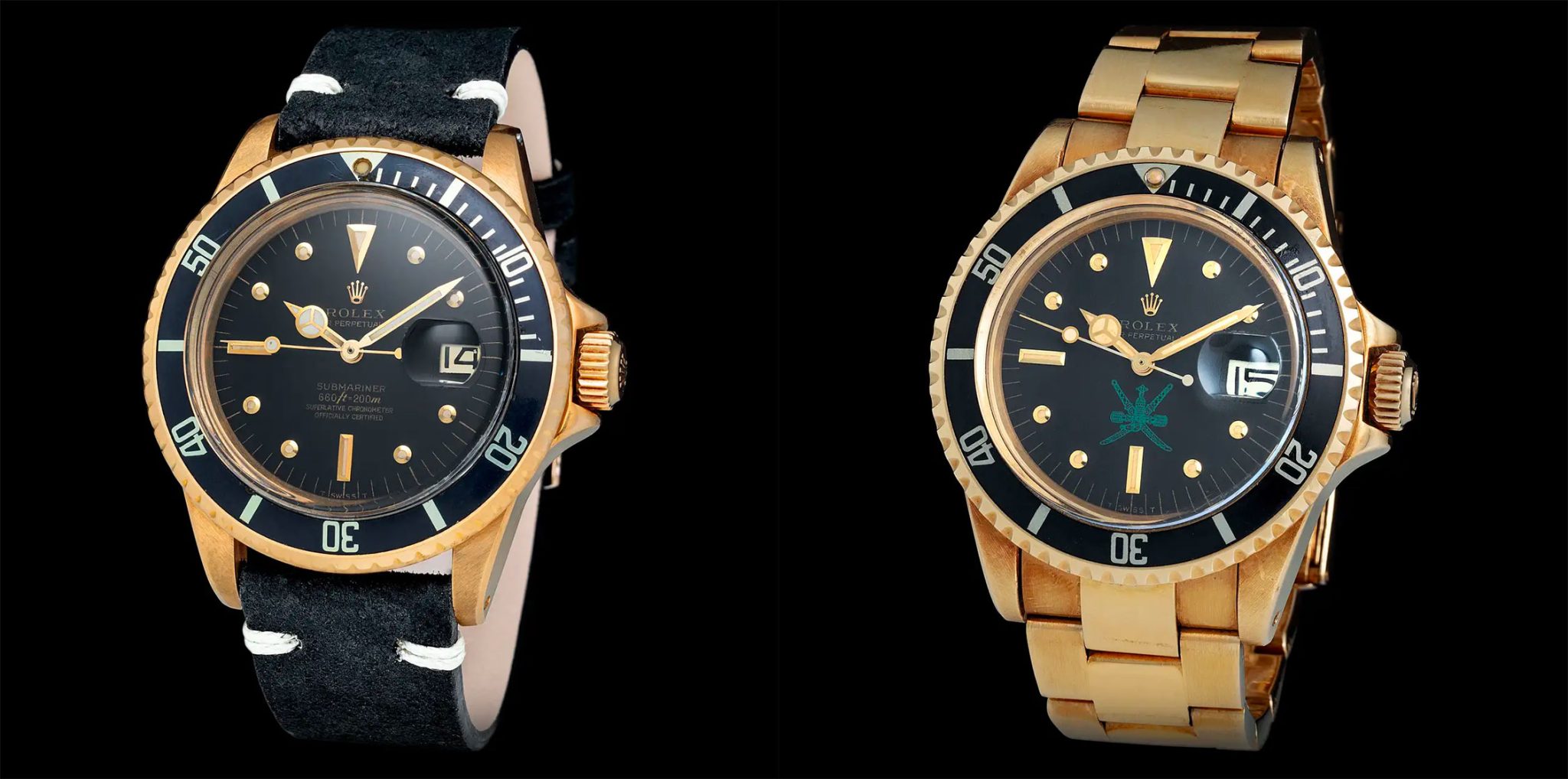
Lot 186: Rolex Submariner ref. 1680 in gold, est. €25,000 – 50,000,
Lot 223: with ‘Khanjar’, est. €250,000 – 500,000 (less affordable, as the logo and bracelet increase the estimate tenfold).
LOT 168
Gold seems a more logical metal for the GMT Master than for Submariners. The case is slimmer and the design of the watch is suitable for less sporty occasions. The value of gold GMTs has developed favourably for owners in recent years (lot 79 ref. 1675, lot 102 ref. 16758).
Lot 168 is a particularly rare model. In the early 1960s, the debut model 6542 was replaced by reference 1675. On the case, the delicate plastic bezel (‘Bakelite’) was replaced by an aluminium component, while the case flank was given shoulders to protect the crown.
However, the gold 1675 models continued to be delivered without crown protection until the mid-1960s. These pieces also differ from steel watches of the period with their traditional (‘alpha’) hands. A surcharge is paid for such pieces. Therefore the, comparatively low valuation of lot 168 is very surprising.
The dial is correct for the watch, as can be seen from the hyphen between ‘Oyster’ and ‘Perpetual’. The hyphen was omitted from later models with crown protectors.
Only the bezel inlay seems to have been retro-fitted. With a little luck, period parts can still be found today with careful searching. Every vintage watch must be examined in detail before purchase to avoid mistakes. In the case of this lot, the low valuation certainly invites this.
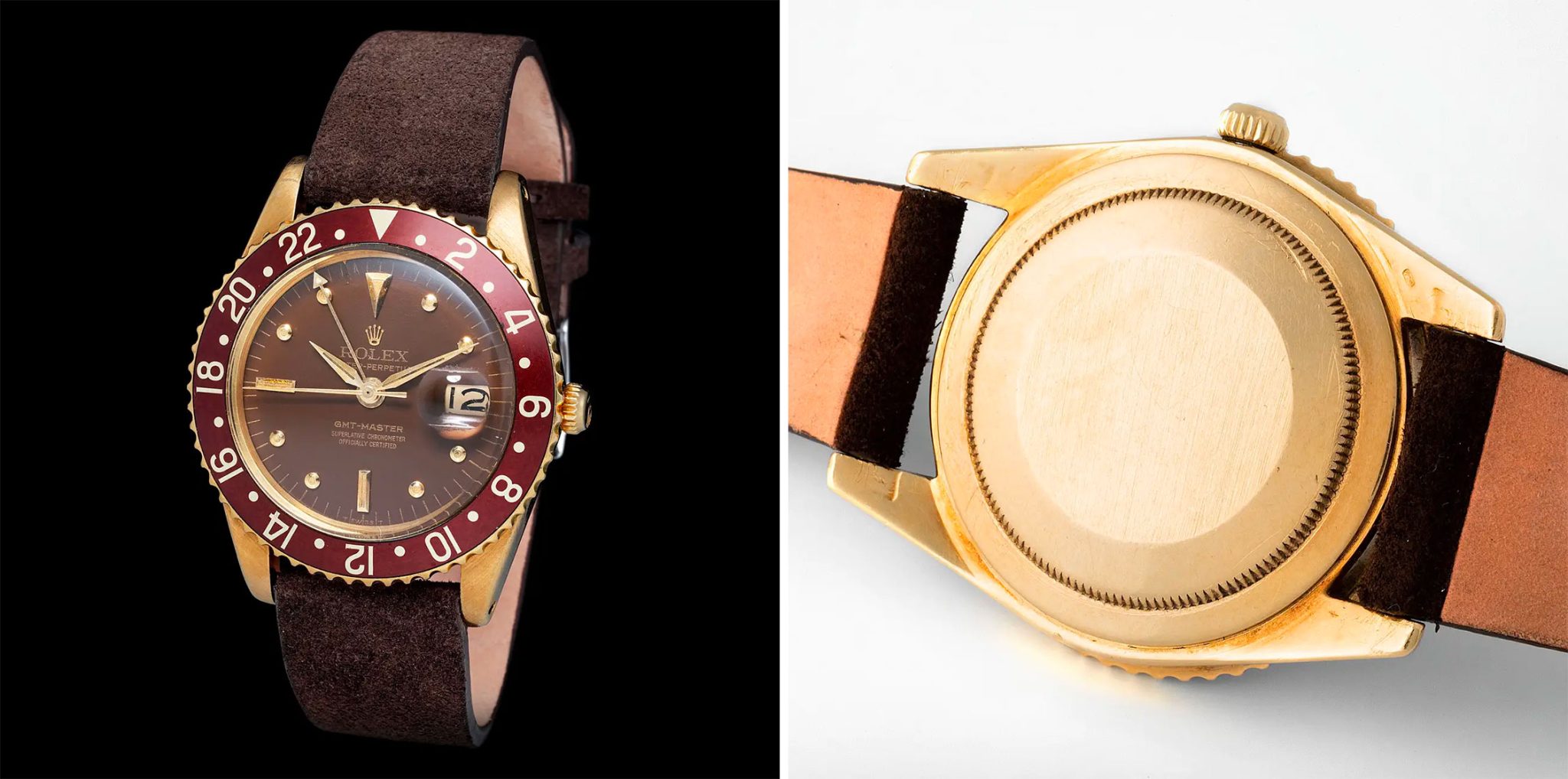
Lot 168: Rolex GMT Master Ref. 1675 ‘No Crown Guards’, est. €15,000 – 30,000
LOT 61
Datejust lovers will also get their fill this year. Personally, I really like lot 61, a Datejust Ref. 16030 with a beautiful blue sunburst dial and Saudi Arabian logo.
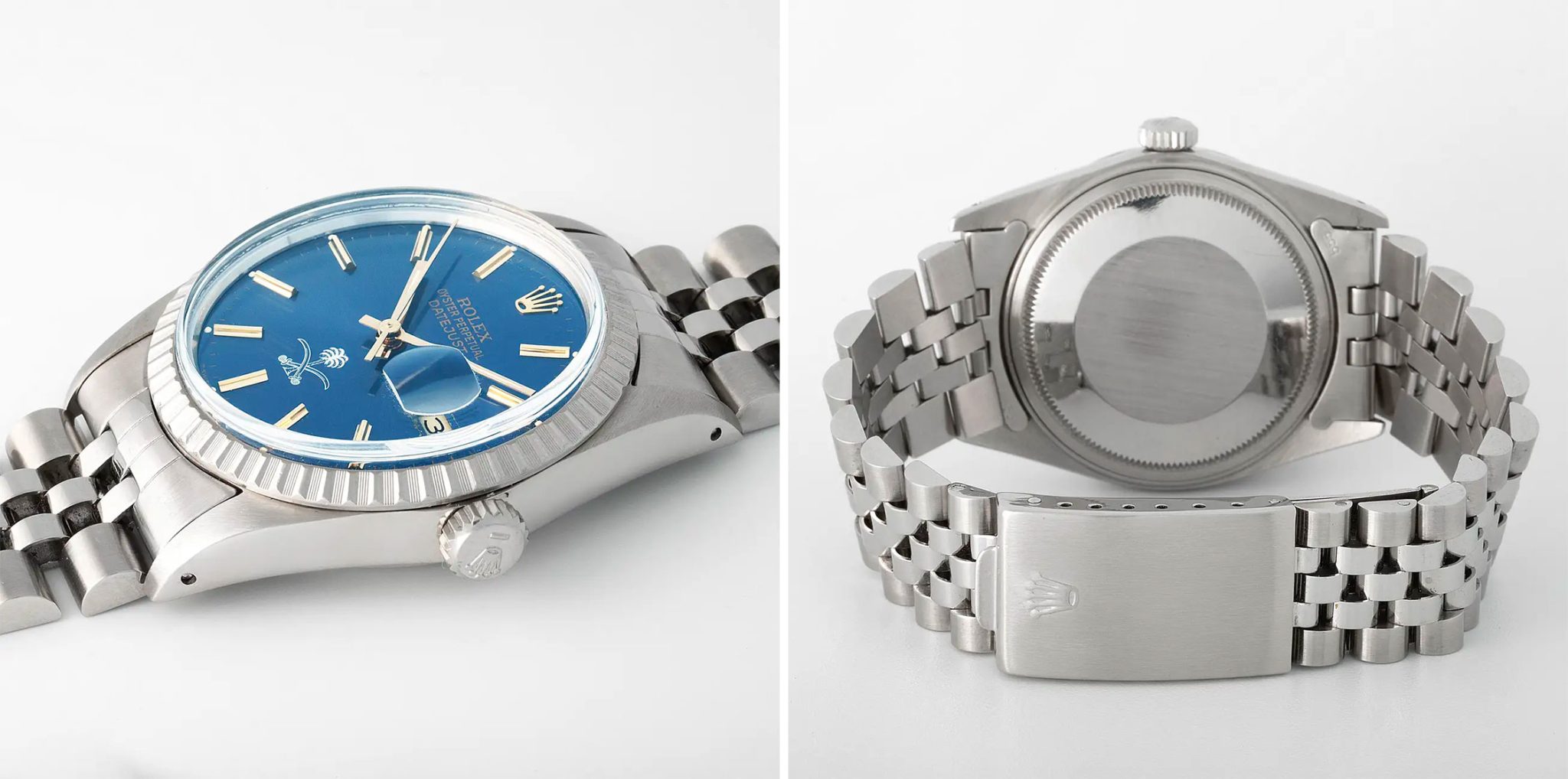
Lot 61: Rolex Ref. 16030 with customised dial, est. €5,000 – 10,000
LOT 150
A particularly glamorous variation can be found in the lot 150 in rose gold, with a brown ‘Doorstop Dial’. The dial takes its name from the indexes at 6 and 9 o’clock, which slope down to the centre in a wedge shape.
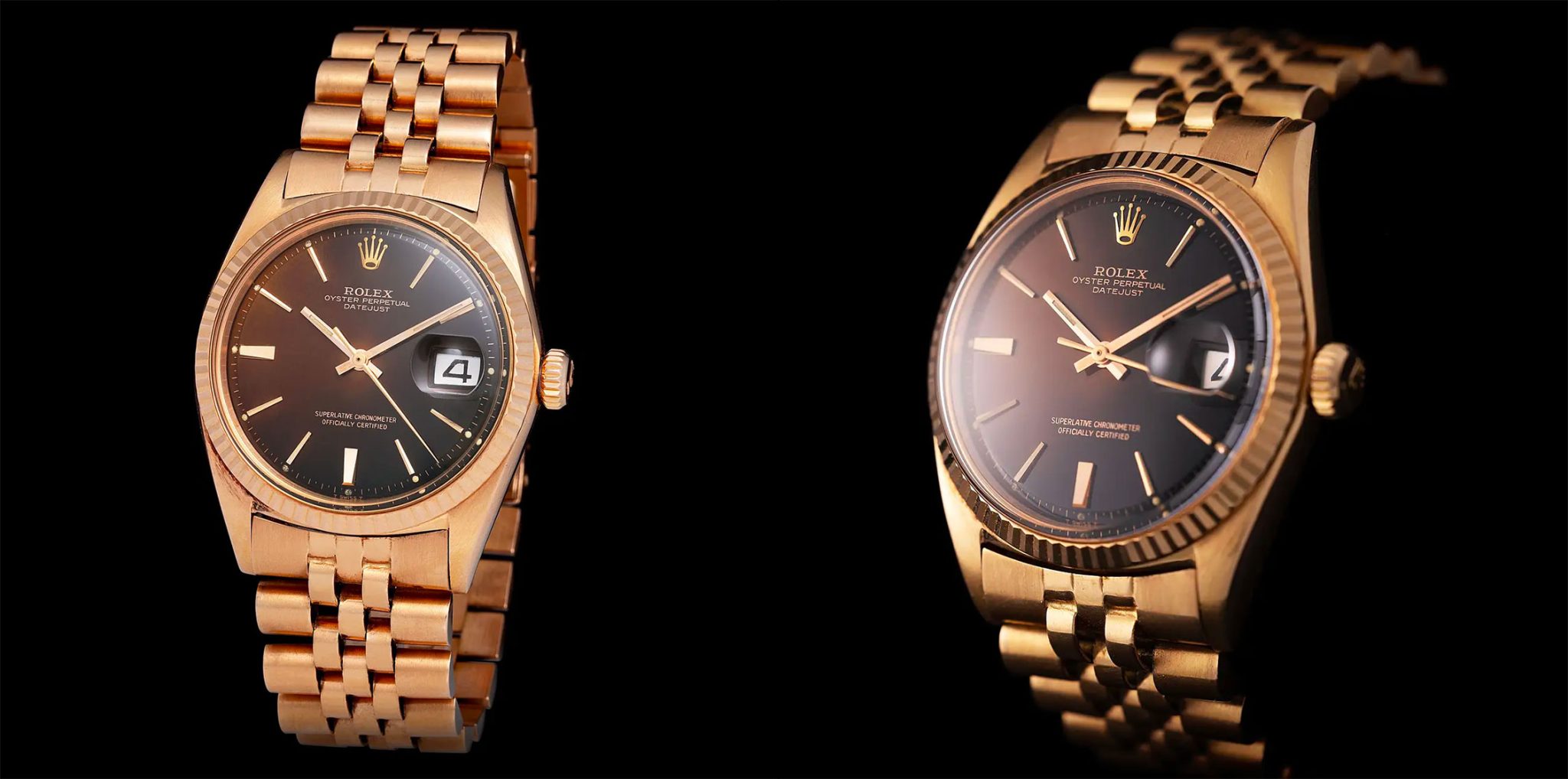
Lot 150: gold Rolex Datejust Ref. 1601 with brown ‘Doorstop’ Dial, est. €30,000 – 60,000
LOS 228
Lot 228 is a Datejust 1601 in white gold with a matching white-gold Jubilee bracelet. Watches like this are very rare. They can only be distinguished from steel watches at first glance by the softer rounded case flank between the lugs.
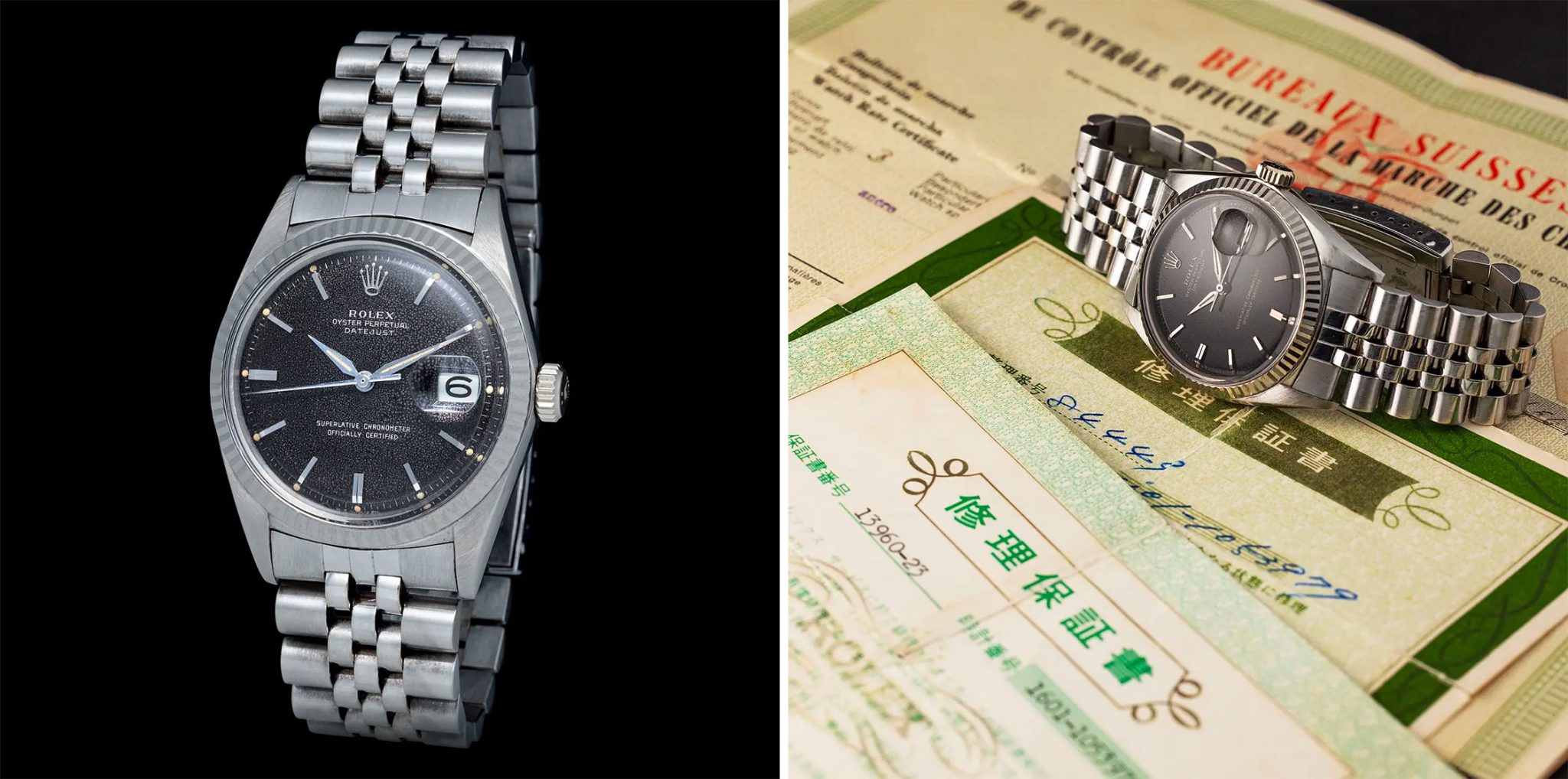
Lot 228: Rolex Datejust ref. 1601 in white gold, est. €30,000 – 60,000
LOS 202
Finally, to the early chronographs by Rolex; for many enthusiasts, the holy grail of their passion. In the 1930s, the popularity of chronograph wristwatches grew rapidly. All the well-known manufactures tried their hand at the segment, with the watches taking a wide range of forms. Rolex was no exception. In a manner typical of the brand, a large number of different models were offered in order to explore the tastes of the clientele as a sort of market research. The inconsistent response to the models resulted in some of the smallest batches which made some references of this era sought-after collector’s trophies today.
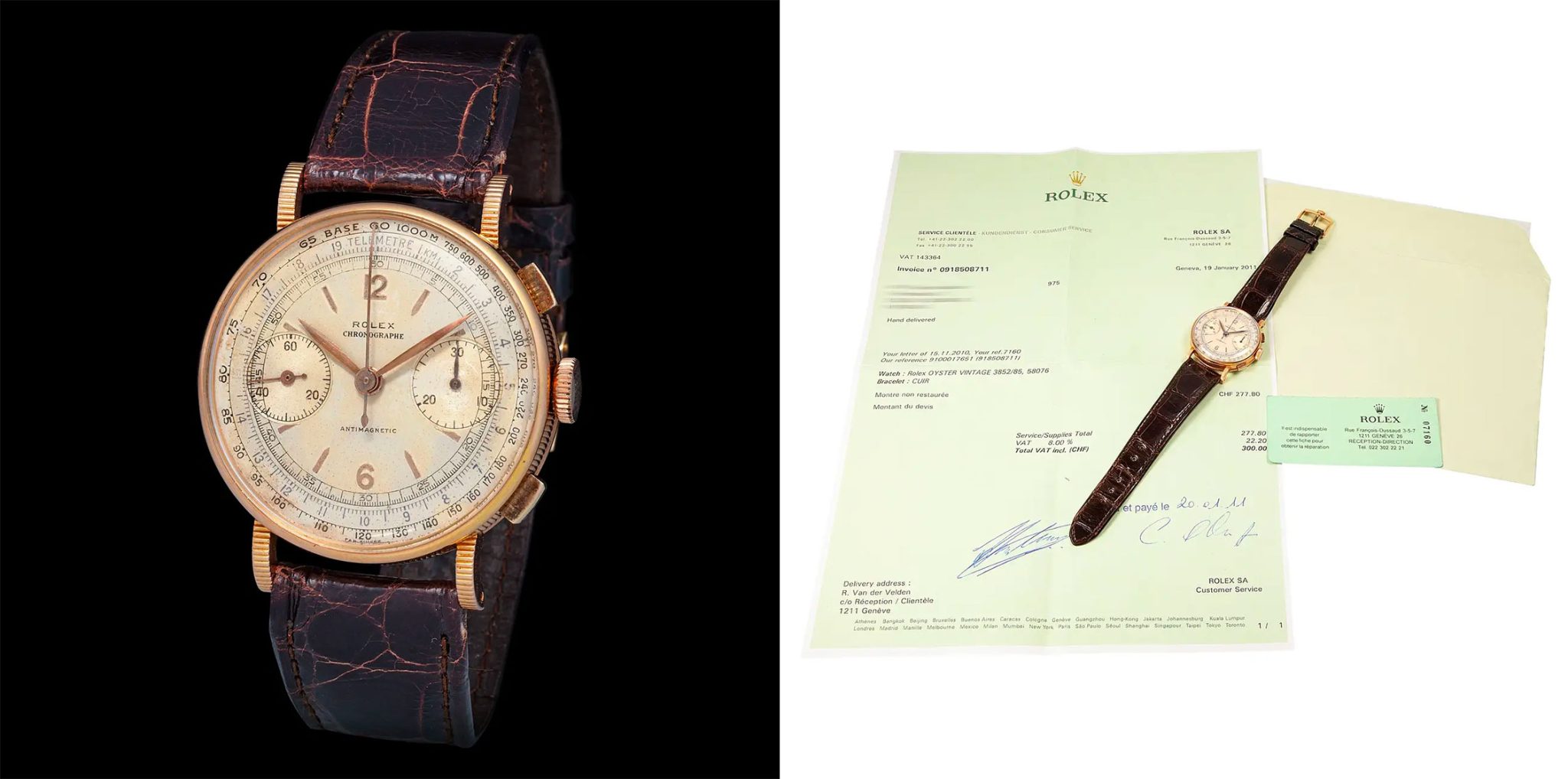
Lot 202: Rolex Ref. 3852, with ‘Coin Edge’ and reeded lugs, one of two known examples, est. €25,000 – 50,000
Rolex already enjoyed good wristwatch sales during the First World War and the introduction of the ‘Oyster Perpetual’ in 1931 had proved a resounding success. With the dawn of the next dark age in Europe, it was clear to Rolex that the Oyster concept would also have to be implemented for chronographs. Chronographs in water-resistant cases were perfect for military purposes.
However, Rolex’s then sister company in Biel did not yet produce chronograph calibres. Attempts to offer conventional movements with a simple stop function in the Oyster case failed, because the ‘start-stop-reset’ standard with two pushers was already established on the market.
So, Rolex did what its competitors had done: it bought movements for the Oyster Chronograph series externally. From the very beginning, only calibres from the manufacturer Valjoux were used. The history of Valjoux began in 1901 under the name ‘Reymond Frères’, founded by the brothers John and Charles Reymond in the Vallée de Joux. From the beginning, the manufacture specialised in chronographs. The reliable ‘Ebauches’ were also used by the top brands Patek Philippe, Vacheron Constantin and Audemars Piguet. In 1929, the company changed its name to ‘Valjoux’ and went under the protection of the Ebauches SA cartel. What remained of the ‘Reymond Frères’ Brand name was the ‘R’ in the cloud logo.

Ebauches SA 1949, Member Logos, Catalogue Officielle, Les Fabricants Suisses D’Horlogerie 1949.
LOT 116
Around 1939, Rolex launched the reference 3525 with the 13-ligne (29.5 mm) movement ‘Valjoux VZ’ with constant seconds at 9 o’clock and minute counter at 3 o’clock. It was the first Oyster chronograph to be sold in large numbers. The smaller model 3481 with the 10.5 lignes movement ‘Valjoux 69’ is, just like the reference 3668 with the ‘engine-turned bezel’, are rarely found today.
The reference 3525, on the other hand, was available in a wide variety of configurations. Particularly rare are watches in steel/gold (‘Rolesor’), like lot 116, which is offered with a matching ‘Grain de Riz’ bracelet – also super rare.
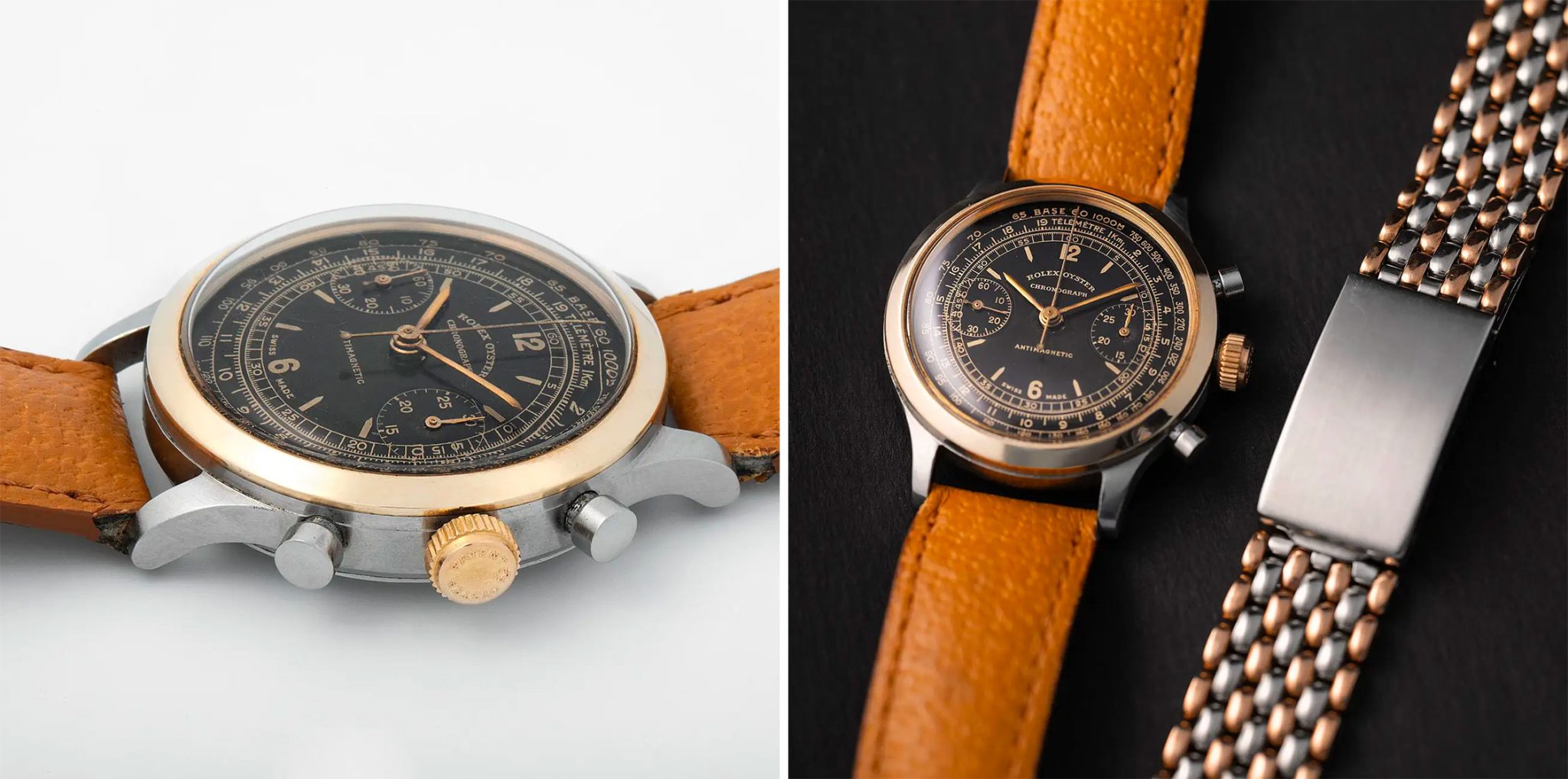
Lot 116: Rolex Ref. 3525 in ‘Rolesor’, with ‘gilt’ dial without luminous material and ‘Grain de Riz’ bracelet, est. €60,000 – 120,000
In the mid-1940s, Valjoux introduced a variation of the 13-ligne basic ‘VZ’ movement with an additional hour register at 6 o’clock (‘VZH’). The hour module was mounted on the dial side, increasing the construction height of the base movement from 5.85 to 6.95 mm.
Without building up the movement any further, calendar (VJ VZHC) and moonphase (VJ VZHCL) modules could now be added. Thus, Valjoux created a range of four different chronograph movements in the much sought-after 29.5 mm format.
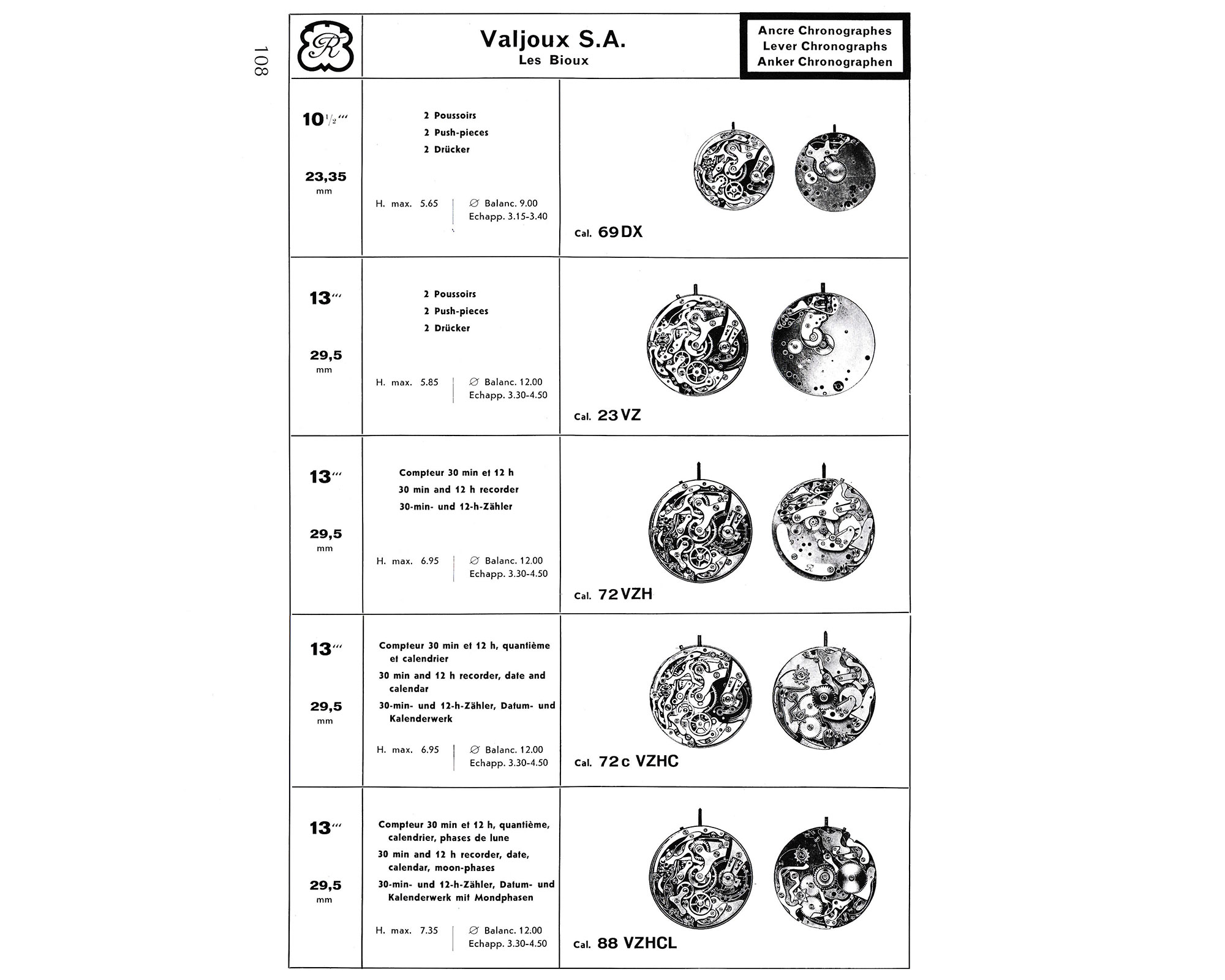
Rolex used all Valjoux 13-ligne calibres based on the VJ 23 base movement over time, except for the calendar chronograph with moonphases. Genuine Rolex watches with ‘VJ VZHCL/ 88’ are not known.
The ‘VJ VZH’ movement with three registers was first used in the model 4048. The case had a ‘Calatrava’ shape, similar to the 3525, but was slightly thicker. Only a few examples exist, but with its 3-register movement, it already carried the DNA of the Daytona.
LOT 80 and LOT 20
Rolex replaced all Oyster chronographs in the ‘Calatrava’ case in the mid-1940s with a new product line, which, featuring a tonneaucase, became a early precursor of the Daytona.
Reference 4500 replaced the successful 3525 model, reference 4537 replaced the short-lived 4048 model, while the 4767 with calendar function was new to the range.
All these references were produced in much smaller numbers than the 3525. One conceivable reason was the coinciding end of the war in 1945. Possibly due to the lower demand for military purposes, the overall demand for chronographs decreased. Nevertheless, these models are of great historical importance, as almost 80 years ago they anticipated the tonneau case shape that is still typical today. But beware, the difference in value between correct ‘investment grade’ watches and restored pieces is very high here.
Lot 80 is a Ref. 4500 in gold with pulsation scale and imprint of the Cuban dealer ‘Joyeria Riviera’. These features make this lot an absolute trophy piece (see also lot 20).
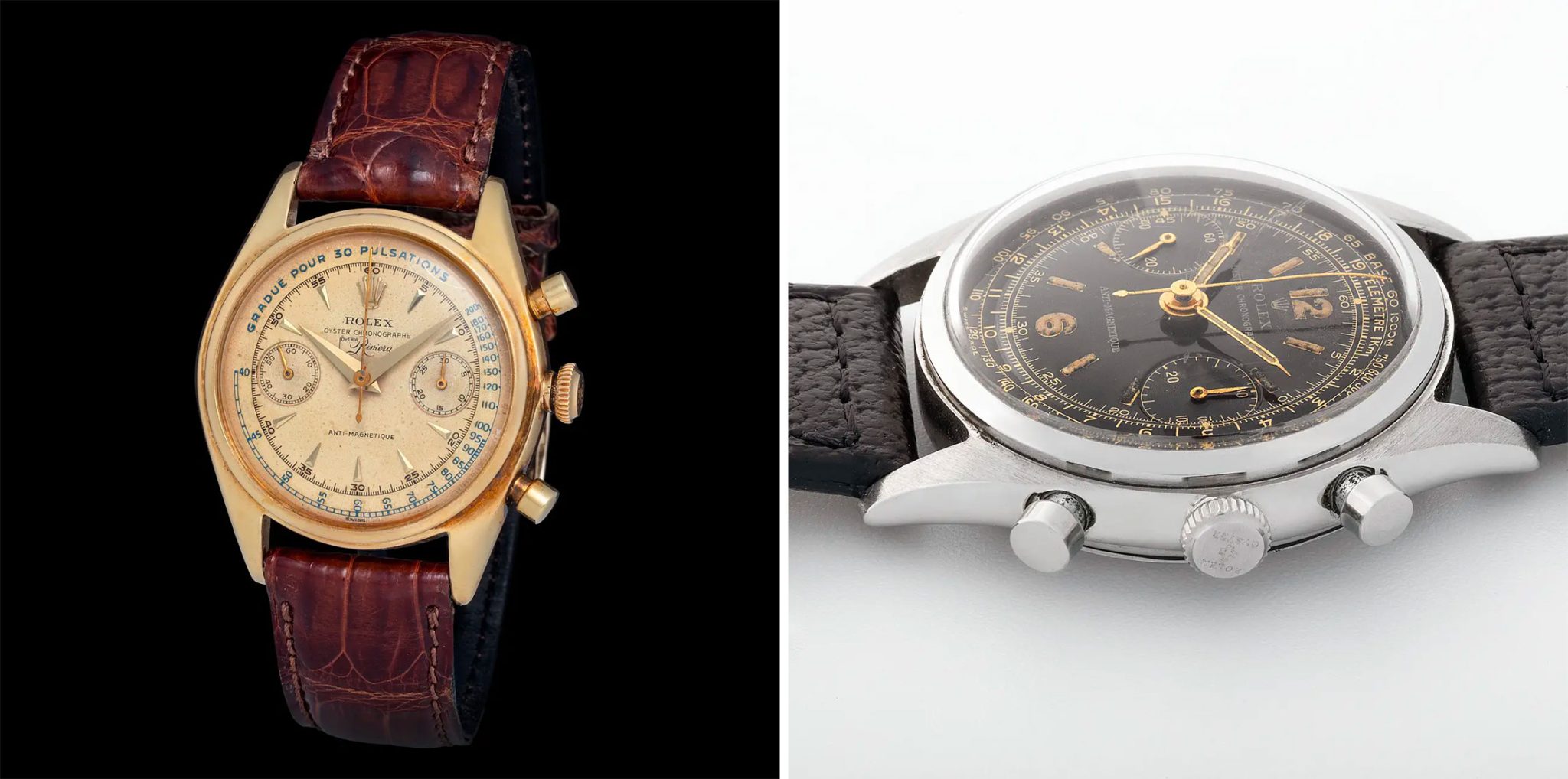
Lot 80, Rolex ref. 4500 in gold ‘Pulsation’, and ‘Riviera’, est., €70,000 – 140,000 and lot 20, in steel with ‘gilt radium dial’, est. €150,000 – 300,000
LOT 38 and LOT 197
Also included are two models of reference 4537. Lot 38 is a very rare gold chronograph. The dial and hands match correctly to the original, and appear to be in good condition. Lot 197 is a steel example, also correct, and features an additional ‘Serpico y Laino’ dealer imprint.
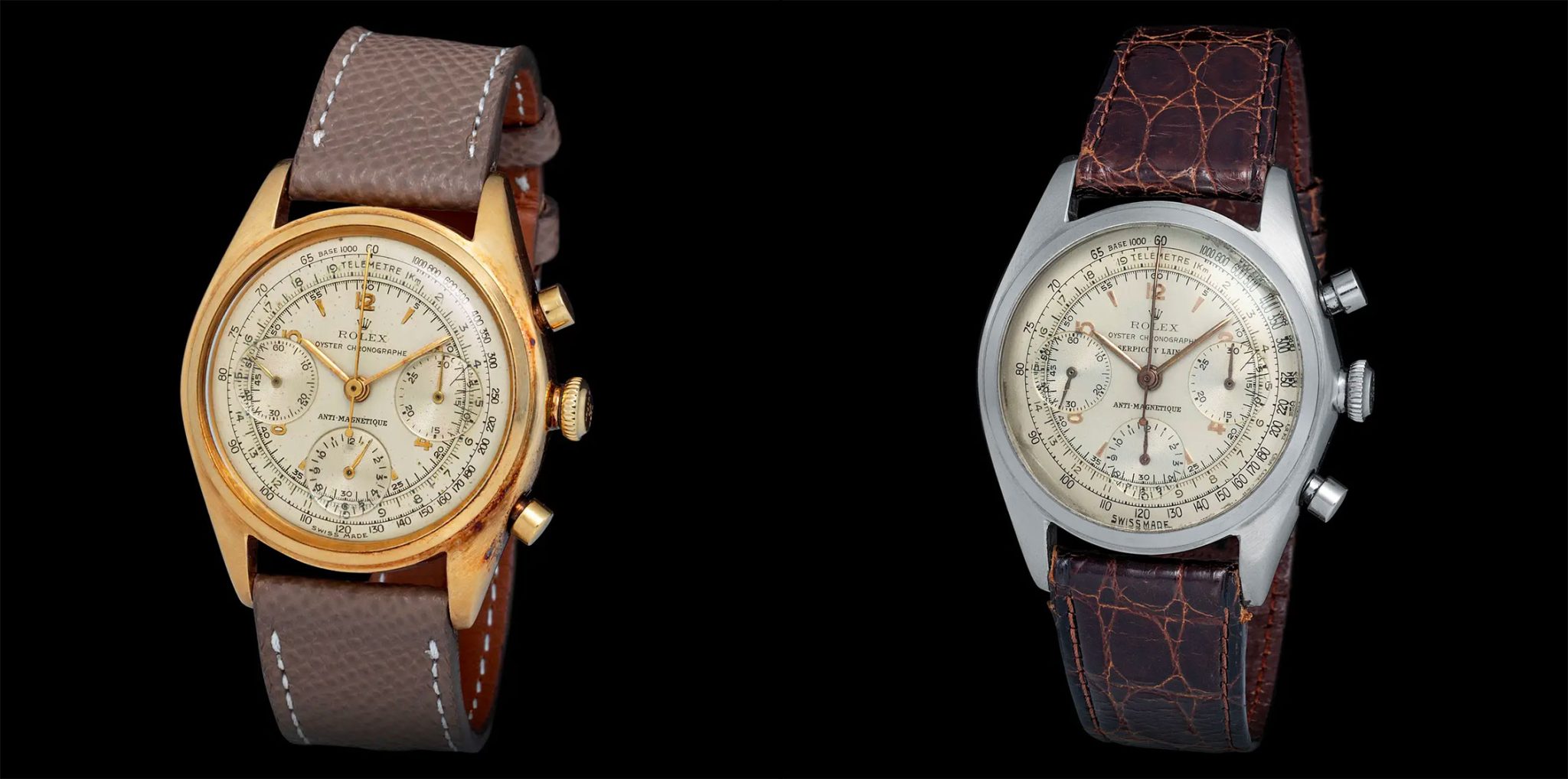
Lot 38, Rolex ref. 4537 in gold, est. € 80,000 – 160,000 and lot 197 in steel ‘Serpico y Laino’, est. € 70,000 – 140,000
In the late 1940s, Valjoux replaced the 13-ligne ‘VZ’ range with the ‘Valjoux 23’ (base calibre with constant seconds and minute counter), ‘Valjoux 72’ with hour register and the model 72c with an additional annual calendar. The article code is engraved on the recess below the balance wheel.
The new generation was introduced by Rolex with the 6032, 6034 and 6036 series, in the late 1940s and early 1950s. Few of the intermediate 5034 and 5036 models have yet surfaced. It is also unclear whether specimens with the reference number 5032 exist.
LOT 198
Lot 198 is a well-preserved calendar chronograph ref. 6036, also called ‘Jean Claude Killy’ by fans. Killy was a world-class skier, and has long been associated with Rolex.
Consistently, the shape of the applied Rolex crown under the calendar window is typical of the years 1949 and 1950. The screw-down crown of earlier references was replaced by a 6 mm ‘Super Oyster’ crown in the original model, as is the case here.
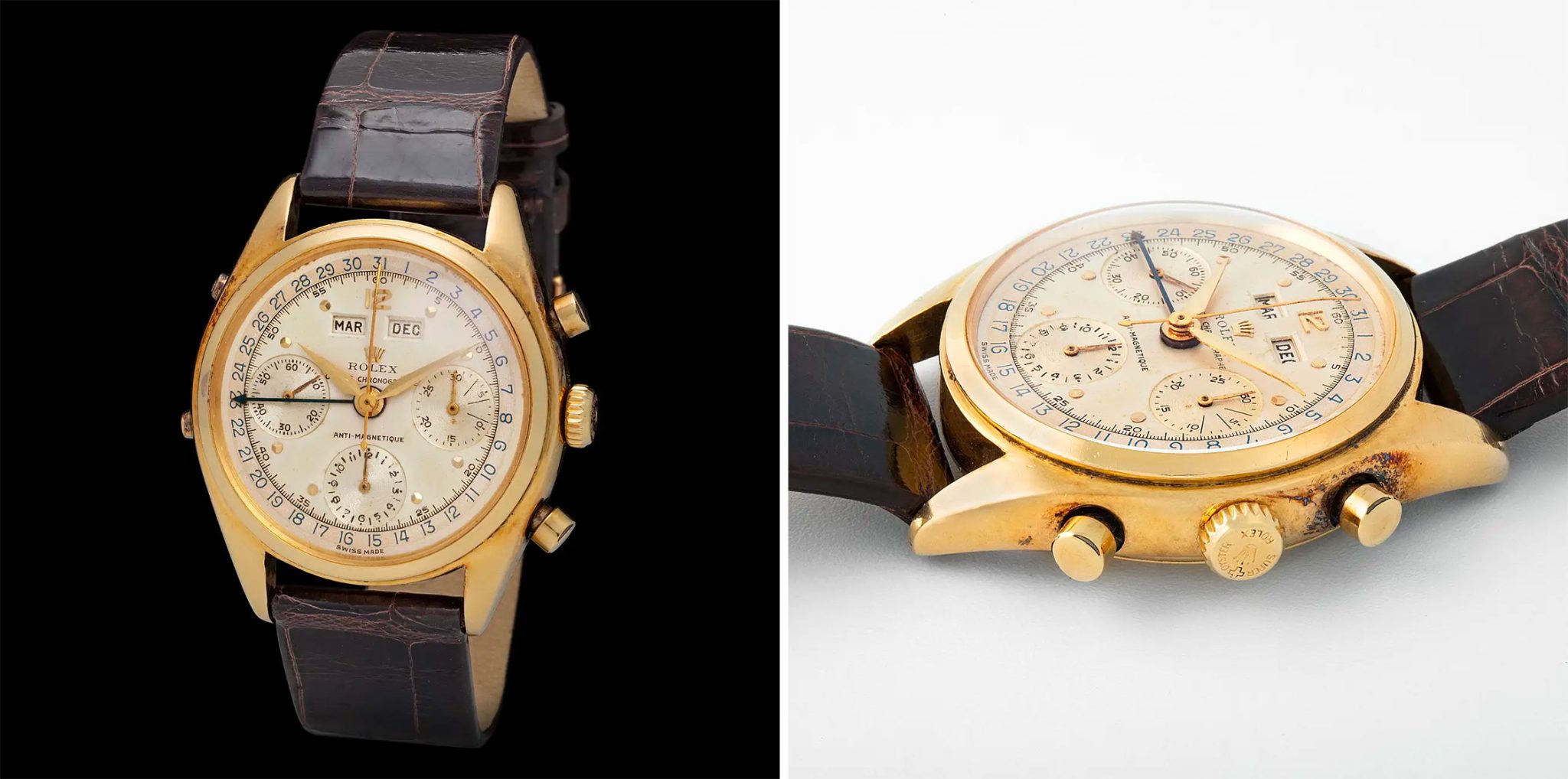
Lot 198: Rolex Ref. 6036 in gold, ‘Super Oyster’, est. € 300,000 – 600,000
In addition to the lots discussed, there are several other interesting watches to explore. The online catalogue is definitely worth taking a look at, and I am already looking forward to the auction. Of course, purchases should only be made after a personal inspection of the goods!


